Paul van Yperen's Blog, page 285
December 30, 2017
Stars Who Passed Away in 2017
On the last day of the year, EFSP remembers twelve stars of the European cinema we had to say goodbye to in 2017. Thanks for your films which will live on forever.
27 January: Emmanuelle Riva (1927–2017)
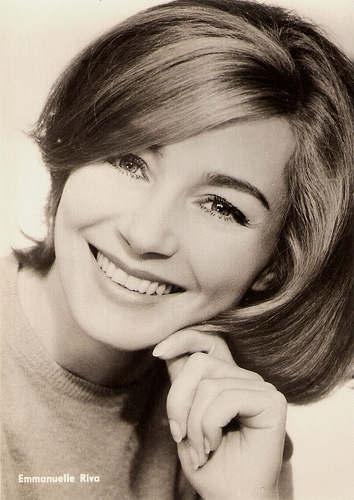
East-German postcard by VEB Progress Filvertrieb, Berlin, no. 1269, 1969. Retail price: 0,20 M. Photo: Unifrance Film. Publicity still for Berufsrisiko/Les risques du métier (André Cayatte, 1967).
On Friday 27 January, French actress Emmanuelle Riva passed away at the age of 89. She became well-known for her roles in the classic Nouveau Vague films Hiroshima mon amour (Alain Resnais, 1959) and Léon Morin, prêtre (Jean-Pierre Melville, 1961). In her 80s, Emmanuelle Riva became an icon for world cinema all over again with Michael Haneke's Amour (2012). Riva received both the Bafta and the César award for her role as the retired music teacher Anne in Amour. She was also nominated for an Oscar for her touching performance.
22 March: Tomas Milian (1933-2017)
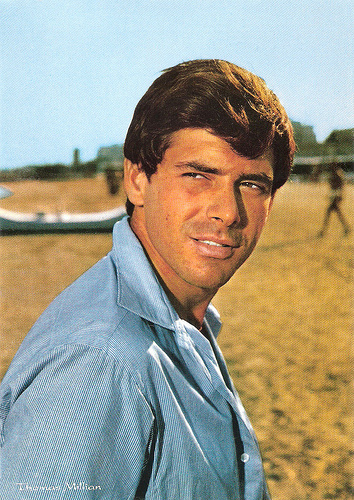
Italian postcard by Rotalfoto, Milano, in the series Artisti di sempre, no. 118.
In March, Cuban-American actor Tomas Milian passed away at the age of 84. He worked extensively in Italian films from the early 1960s to the late 1980s. Milian played neurotic and sadistic killers in several Spaghetti Westerns of the 1960s and lone-wolf anti-heroes in violent action and police thrillers of the 1970s. Very popular in Italy were his crime-comedies of the late 1970s and 1980s. Besides these genre films, he worked with such prolific directors as Mauro Bolognini, Luchino Visconti, Bernardo Bertolucci and Michelangelo Antonioni.
18 April: Yvonne Monlaur (1939-2017)
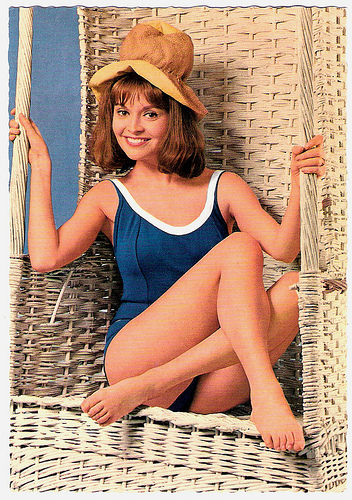
German postcard by Krüger, no. 902/395. Photo: Gérard Decaux.
French film actress Yvonne Monlaur passed away in April at the age of 77. She starred in several European film productions of the late 1950s and 1960s. The glamorous French starlet is best known for her roles in a few Hammer horror films.
23 May: Roger Moore (1927-2017)
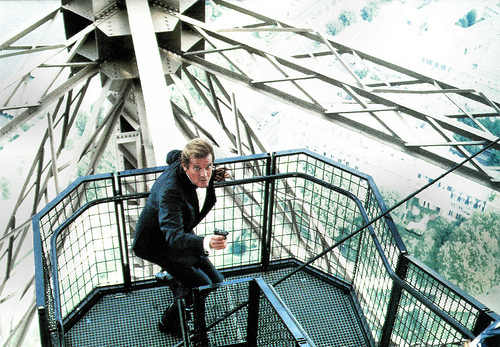 14
14
Dutch postcard by Loeb Uitgevers BV, Amsterdam, 1985. Photo: Eon Productions / Gilrose Publications / Danjaq S.A. Publicity still for A View To A Kill (John Glen, 1985).
British actor Roger Moore died in May. He will always be remembered as the guy who replaced Sean Connery in the James Bond series, but he was also our favourite Ivanhoe, Saint and Persuader on TV. Roger Moore was 89.
17 June: Anneliese Uhlig (1918-2017)
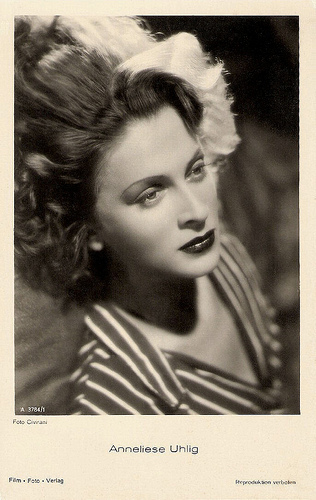
German Postcard by Film-Foto-Verlag, no. A 3784/1, 1941-1944. Photo: Civirani.
German actress Anneliese Uhlig passed away at the age of 98. She was an elegant and enchanting femme fatale of Ufa crime films of the 1940s. The classic beauty unwillingly bewitched Joseph Goebbels. After the war she also worked internationally as a journalist, theatre producer and university teacher. She became an American citizen and died in Santa Cruz in California.
8 July: Elsa Martinelli (1935-2017)
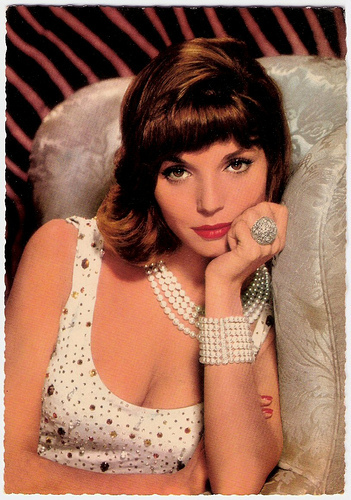
German postcard by Krüger, no. 902/255.
Glamorous Italian actress and former fashion model Elsa Martinelli died in July. She showed her beautiful curves in many European and Hollywood productions of the 1950s and 1960s, but somehow she never became the star she was destined to become in the mid-1950s. Martinelli was 82.
31 July: Jeanne Moreau (1928-2017)

French postcard by E.D.U.G., no. 81. Photo: Sam Lévin.
French actress Jeanne Moreau died this summer at the age of 89. Moreau was the personification of French womanhood and sensuality. She had a diverse career: she was a magnificent stage and film actress, a producer, screenwriter and film director, a successful singer with a substantial recording career, and a theatre and opera director. Throughout her long career in the cinema with more than 130 films, Jeanne Moreau worked with some of the most notable film directors ever. She combined off-kilter beauty with strong character in Nouvelle Vague classics as Ascenseur pour l'échafaud (Louis Malle, 1958) and Les amants (Louis Malle, 1959). Her role as the flamboyant, free-spirited Catherine with her devil-may-care sensuality in Jules et Jim (François Truffaut, 1962) is one of the greatest performances in the history of the cinema.
20 August: Margot Hielscher (1919-2017)
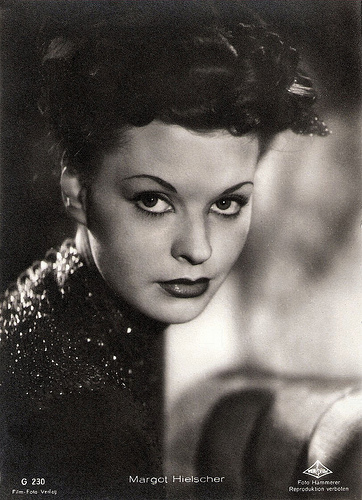
German postcard by Film-Foto-Verlag, no. G 230. 1941-1944. Photo: Hammerer / Wien-Film.
German singer, film actress and costume designer Margot Hielscher (1919-2017) passed away in August. During her long career, she appeared in 60 films and 200 TV productions. Hielscher also represented Germany twice at the Eurovision Song Contest, in 1957 and 1958. Hielscher
26 September 2017: Kveta Fialová (1929-2017)
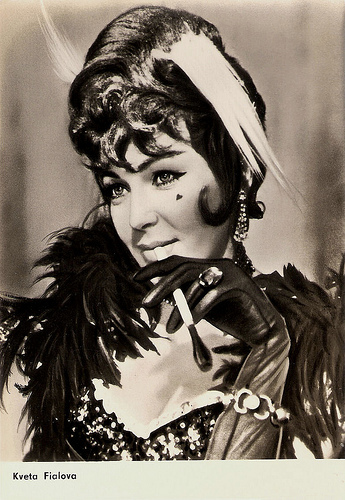
East-German postcard by VEB Progress Film-Vertrieb, no. 2.125, 1964. Photo: Limonádový Joe aneb Konská opera/Lemonade Joe (Oldrich Lipský, 1964).
In September Czech actress Květa Fialová passed away at the age of 88. In her country, she was a popular theatre, film and television diva. Internationally she is best known for her role as bar singer Tornado Lou in the Western parody Limonádový Joe aneb Konská opera/Lemonade Joe (Oldrich Lipský, 1964).
17 October: Danielle Darrieux (1917-2017)
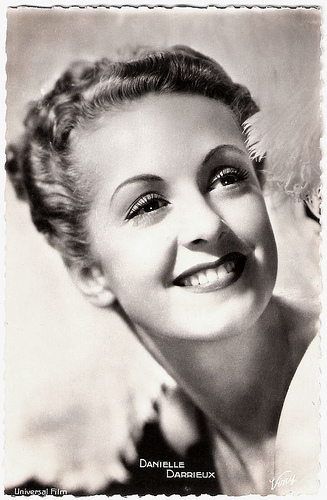
French postcard by Viny, no. 70. Photo: Universal Film.
In October, French actress and singer Danielle Darrieux (1917-2017) passed away. She was a beautiful, international leading lady whose eight-decade career was among the longest in film history. From her film debut in 1931 on she played in more than 110 films in which she progressed from playing pouting teens to worldly sophisticates. In the early 1950s she starred in three classic films by Max Ophüls, and she played the mother of Catherine Deneuve in five films! Danielle Darrieux was 100.
10 November 2017: Erika Remberg (1932-2017)
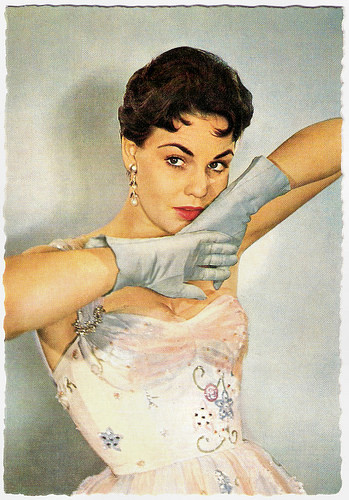
German postcard by WS-Drück, Wanne-Eickel, no. F 100. Photo: Huster.
In November Erika Remberg passed away at the age of 85. Long ago we saw the beautiful Austrian film actress in the tearjerker Laila/Make Way for Lila (Rolf Husberg, 1958), as a foundling who is adopted and raised by a Lapland chieftain. Remberg appeared in 31 films between 1950 and 1970, but we want to remember her as lovely Laila.
6 December: Johnny Hallyday (1943-2017)
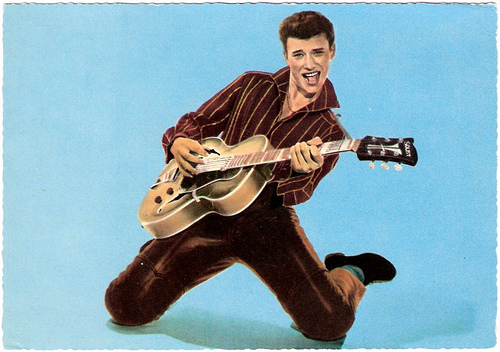
German postcard by ISV, no. H 85.
The father of French Rock and Roll is dead. Flamboyant singer and actor Johnny Hallyday passed away on 6 December. He was a European teen idol in the 1960s with record-breaking crowds and mass hysteria, but he never became popular in the English-speaking market. In later years he concentrated on being an actor and appeared in more than 35 films. Hallyday was 74.
27 January: Emmanuelle Riva (1927–2017)

East-German postcard by VEB Progress Filvertrieb, Berlin, no. 1269, 1969. Retail price: 0,20 M. Photo: Unifrance Film. Publicity still for Berufsrisiko/Les risques du métier (André Cayatte, 1967).
On Friday 27 January, French actress Emmanuelle Riva passed away at the age of 89. She became well-known for her roles in the classic Nouveau Vague films Hiroshima mon amour (Alain Resnais, 1959) and Léon Morin, prêtre (Jean-Pierre Melville, 1961). In her 80s, Emmanuelle Riva became an icon for world cinema all over again with Michael Haneke's Amour (2012). Riva received both the Bafta and the César award for her role as the retired music teacher Anne in Amour. She was also nominated for an Oscar for her touching performance.
22 March: Tomas Milian (1933-2017)

Italian postcard by Rotalfoto, Milano, in the series Artisti di sempre, no. 118.
In March, Cuban-American actor Tomas Milian passed away at the age of 84. He worked extensively in Italian films from the early 1960s to the late 1980s. Milian played neurotic and sadistic killers in several Spaghetti Westerns of the 1960s and lone-wolf anti-heroes in violent action and police thrillers of the 1970s. Very popular in Italy were his crime-comedies of the late 1970s and 1980s. Besides these genre films, he worked with such prolific directors as Mauro Bolognini, Luchino Visconti, Bernardo Bertolucci and Michelangelo Antonioni.
18 April: Yvonne Monlaur (1939-2017)

German postcard by Krüger, no. 902/395. Photo: Gérard Decaux.
French film actress Yvonne Monlaur passed away in April at the age of 77. She starred in several European film productions of the late 1950s and 1960s. The glamorous French starlet is best known for her roles in a few Hammer horror films.
23 May: Roger Moore (1927-2017)
 14
14Dutch postcard by Loeb Uitgevers BV, Amsterdam, 1985. Photo: Eon Productions / Gilrose Publications / Danjaq S.A. Publicity still for A View To A Kill (John Glen, 1985).
British actor Roger Moore died in May. He will always be remembered as the guy who replaced Sean Connery in the James Bond series, but he was also our favourite Ivanhoe, Saint and Persuader on TV. Roger Moore was 89.
17 June: Anneliese Uhlig (1918-2017)

German Postcard by Film-Foto-Verlag, no. A 3784/1, 1941-1944. Photo: Civirani.
German actress Anneliese Uhlig passed away at the age of 98. She was an elegant and enchanting femme fatale of Ufa crime films of the 1940s. The classic beauty unwillingly bewitched Joseph Goebbels. After the war she also worked internationally as a journalist, theatre producer and university teacher. She became an American citizen and died in Santa Cruz in California.
8 July: Elsa Martinelli (1935-2017)

German postcard by Krüger, no. 902/255.
Glamorous Italian actress and former fashion model Elsa Martinelli died in July. She showed her beautiful curves in many European and Hollywood productions of the 1950s and 1960s, but somehow she never became the star she was destined to become in the mid-1950s. Martinelli was 82.
31 July: Jeanne Moreau (1928-2017)

French postcard by E.D.U.G., no. 81. Photo: Sam Lévin.
French actress Jeanne Moreau died this summer at the age of 89. Moreau was the personification of French womanhood and sensuality. She had a diverse career: she was a magnificent stage and film actress, a producer, screenwriter and film director, a successful singer with a substantial recording career, and a theatre and opera director. Throughout her long career in the cinema with more than 130 films, Jeanne Moreau worked with some of the most notable film directors ever. She combined off-kilter beauty with strong character in Nouvelle Vague classics as Ascenseur pour l'échafaud (Louis Malle, 1958) and Les amants (Louis Malle, 1959). Her role as the flamboyant, free-spirited Catherine with her devil-may-care sensuality in Jules et Jim (François Truffaut, 1962) is one of the greatest performances in the history of the cinema.
20 August: Margot Hielscher (1919-2017)

German postcard by Film-Foto-Verlag, no. G 230. 1941-1944. Photo: Hammerer / Wien-Film.
German singer, film actress and costume designer Margot Hielscher (1919-2017) passed away in August. During her long career, she appeared in 60 films and 200 TV productions. Hielscher also represented Germany twice at the Eurovision Song Contest, in 1957 and 1958. Hielscher
26 September 2017: Kveta Fialová (1929-2017)

East-German postcard by VEB Progress Film-Vertrieb, no. 2.125, 1964. Photo: Limonádový Joe aneb Konská opera/Lemonade Joe (Oldrich Lipský, 1964).
In September Czech actress Květa Fialová passed away at the age of 88. In her country, she was a popular theatre, film and television diva. Internationally she is best known for her role as bar singer Tornado Lou in the Western parody Limonádový Joe aneb Konská opera/Lemonade Joe (Oldrich Lipský, 1964).
17 October: Danielle Darrieux (1917-2017)

French postcard by Viny, no. 70. Photo: Universal Film.
In October, French actress and singer Danielle Darrieux (1917-2017) passed away. She was a beautiful, international leading lady whose eight-decade career was among the longest in film history. From her film debut in 1931 on she played in more than 110 films in which she progressed from playing pouting teens to worldly sophisticates. In the early 1950s she starred in three classic films by Max Ophüls, and she played the mother of Catherine Deneuve in five films! Danielle Darrieux was 100.
10 November 2017: Erika Remberg (1932-2017)

German postcard by WS-Drück, Wanne-Eickel, no. F 100. Photo: Huster.
In November Erika Remberg passed away at the age of 85. Long ago we saw the beautiful Austrian film actress in the tearjerker Laila/Make Way for Lila (Rolf Husberg, 1958), as a foundling who is adopted and raised by a Lapland chieftain. Remberg appeared in 31 films between 1950 and 1970, but we want to remember her as lovely Laila.
6 December: Johnny Hallyday (1943-2017)

German postcard by ISV, no. H 85.
The father of French Rock and Roll is dead. Flamboyant singer and actor Johnny Hallyday passed away on 6 December. He was a European teen idol in the 1960s with record-breaking crowds and mass hysteria, but he never became popular in the English-speaking market. In later years he concentrated on being an actor and appeared in more than 35 films. Hallyday was 74.
Published on December 30, 2017 22:00
December 29, 2017
Claretta Sabatelli
Little is known about Italian actress Claretta Sabatelli. In 1916 she made her debut in the Italian silent cinema and appeared in several films around 1920. After one part in a sound film, she disappeared in oblivion.
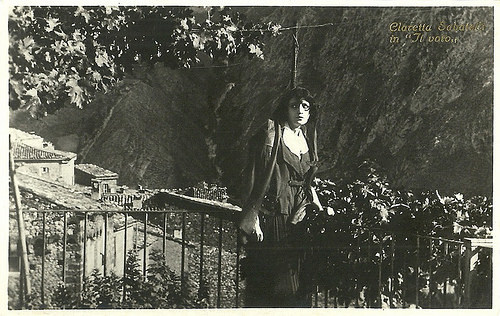
Italian postcard by G.B. Falci, Milano, no. 367. Photo: Fotominio / Aprutium Film. Publicity for Il voto (Eugenio Fontana, 1921).
A young scoundrel climbing over fences
Italian actress Claretta or Clarette Sabatelli made her film debut in L'uomo dall'orecchio mozzato (The Man With the Cut-off Ear, Ubaldo Maria Del Colle, 1916), an adaptation of the novel by Edmond. The plot tells about a man who awakens after 100 years.
It was followed by the comedy Battaglia di reginette (Battle of the Starlets, Domenico Gaido, 1917), Lo scandalo della principessa Giorgio (The Scandal of Princess George, Pier Antonio Gariazzo, 1917) starring Neyse Cheyne (whom critics thought a ravishing beauty but incapable of acting), and La calamita (The Magnet, Giuseppe Pinto, 1919) set and shot in Naples - which Neapolitan critic Tito Alacci thought modest but warm and humane.
The first film in which Sabatelli really had the female lead was the Vay Film production Il frantoio (The Crusher, Giuseppe Zaccaria, 1919), about a poor washing girl who starts working in an office and falls in love with an engineer. Stock exchange speculations by a trust force him to fire his staff and flee to the US, where he works in a mine. His adversary, head of the enemy trust, has lost his daughter and of course it is the girl, returned washing girl. All ends well, the girl finds her father and her future husband. The title refers to a breaker of rocks, used in mines, similar to the splitting of souls in the plot.
Next at Vay Film, Sabatelli starred in L'ombra della morte (The Shadow of Death, Attilio d'Anversa, 1919), scripted by Per Antonio Gariazzo. The press praised Sabbatelli as a young scoundrel climbing over fences and walking over roofs, but thought the plot old-fashioned.
Sabatelli had the lead as Guendalina in Tutto il mondo è teatro/All the World is a Stage (Pier Antonio Gariazzo, 1919), scripted by Lucio d'Ambra and loosely based on William Shakespeare. The plot is about two marionets who after adventures in the real world decide their wooden existence is better.
After a supporting part in La Sacra Bibbia (The Holy Bible, Pier Antonio Gariazzo, 1920), a costly flop according to the press, and a last film at Vay, the negligible I millepiedi (The Milipedes, Attilio d'Anversa, 1920), Sabatelli then shifted to the Roman company Rinascimento Film.
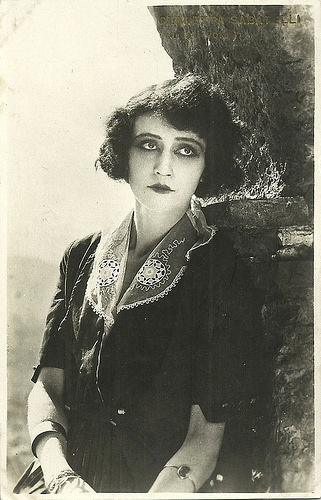
Italian postcard by G.B. Falci, Milano, no. 367. Photo: Fotominio / Aprutium Film. Publicity still of Claretta Sabatelli in Il voto (Eugenio Fontana, 1921).
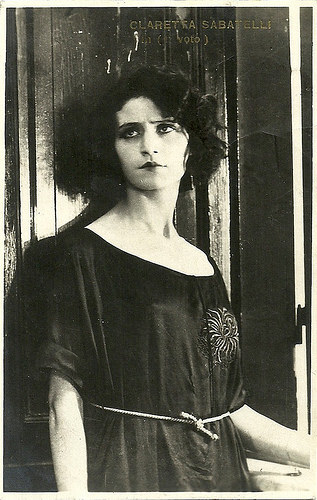
Italian postcard by G.B. Falci, Milano, no. 367. Photo: Fotominio / Aprutium Film. Publicity still for Il voto (Eugenio Fontana, 1921).
Exquisite expressions of deep felt grief and despair
For Rinascimento Film, Claretta Sabatelli first had a supporting part in La naufraga della vita (Life's Shipwrecked, Eugenio Perego, 1920) with Olga and Desdemona Mazza .
Then she played the female lead in Il dramma dell'amore (The Drama of Love, Amleto Palermi, 1920), opposite the monstre sacré of the Italian stage, Giovanni Grasso. While the plot was considered old hat, the press praised the performances of Grasso and Sabatella, who played a poor, seduced young girl.
Aurelio Spada wrote in the Neapolitan magazine Film: "She presents the character with spontaneity and efficacy, assuming exquisite expressions of deep felt grief and despair."
In 1921 Sabatelli acted with the famous vaudeville performer Anna Fougez and Gustavo Serena in Fiore selvaggio (Gustavo Serena, 1921), on a goatkeeper (Fougez) who becomes a grande cocotte in town and eventually returns to her roots.
She then appeared in Il voto (The Vow, Eugenio Fontana, 1921). In the Abruzzi mountains, a fatal woman is not loved by her brutal husband, so she starts an affair with another man, but this is discovered and the lover is killed. Years after, the victim's son returns from Rome to his hometown and he looks so much like his father, that the woman falls in love with him too.
Then one day it is revealed that she is his mother. To recompense, he seeks penitence by going as pilgrim to a sanctuary, where the pilgrims on their knees hit the sins from them. But also the woman comes to redeem her sins. Together they choose death.
The press criticised the script by Ettore Moschino as too artificial. They praised the direction by Eugenio Fontana because of the pictorial qualities of his images. They were also favourable about the performances of Amleto Novelli and Claretta Sabatelli. "She is really becoming an excellent actress", a critic wrote. The film was shot at the Majella in the Abruzzi, and at the Abruzzean coastline. Il voto had its first night in April 1921 at the Corso Cinema Teatro in Rome.
After an interval of some years, Sabatelli tried her luck in comedy in 1924 in Donne, parrucchieri, cani, amori (Women, Hairdressers, Dogs, Loves, Renato Testard, Corradi, 1924) in which the lead Renato Malvasi played an imitation of Larry Semon, known in Italy as Ridolini. The film itself was a spoof of the American film The Hottentot (1922).
Also in 1924 Sabatelli had a supporting part in I volti dell'amore (The Faces of Love, Carmine Gallone, 1924), a star vehicle for Soava Gallone and based on Adrienne Lecouvreur. In 1926 Sabatelli played countess Lilla in Garibaldi e i suoi tempi (Garibaldi and His Times, Silvio Laurenti Rosa, 1926), starring Enrico Benvenuto, and scripted by Umberto Paradisi. In the meantime Sabatelli also performed on stage. In 1925 she mime-danced e.g. at the Teatro degli Independenti.
After a last part in the sound film L'amore si fa così (This Is the Way How to Love, Carlo Ludovico Bragaglia, 1939), Claretta Sabatelli quitted film acting and nothing was heard from her since.
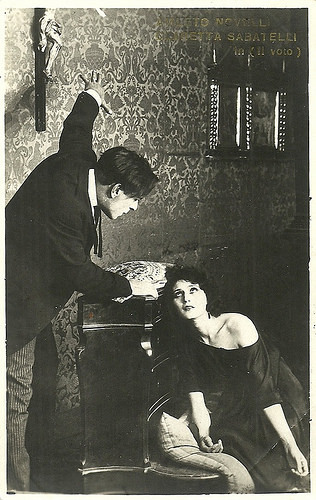
Italian postcard by G.B. Falci, Milano. Photo: Fotominio / Aprutium Film. Publicity still of Claretta Sabatelli and Amleto Novelli in Il voto (Eugenio Fontana, 1921).
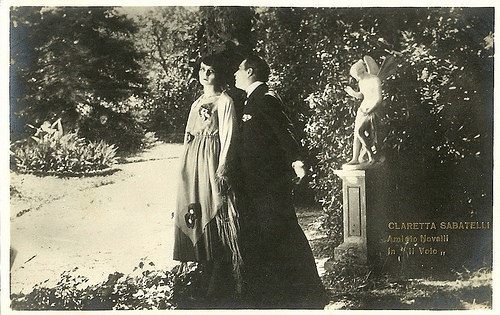
Italian postcard by G.B. Falci, Milano. Photo: Fotominio / Aprutium Film. Publicity still of Claretta Sabatelli and Amleto Novelli in Il voto (Eugenio Fontana, 1921).
Source: Sempre in penombra (Italian), Vittorio Martinelli (Il cinema muto italiano - Italian), and .

Italian postcard by G.B. Falci, Milano, no. 367. Photo: Fotominio / Aprutium Film. Publicity for Il voto (Eugenio Fontana, 1921).
A young scoundrel climbing over fences
Italian actress Claretta or Clarette Sabatelli made her film debut in L'uomo dall'orecchio mozzato (The Man With the Cut-off Ear, Ubaldo Maria Del Colle, 1916), an adaptation of the novel by Edmond. The plot tells about a man who awakens after 100 years.
It was followed by the comedy Battaglia di reginette (Battle of the Starlets, Domenico Gaido, 1917), Lo scandalo della principessa Giorgio (The Scandal of Princess George, Pier Antonio Gariazzo, 1917) starring Neyse Cheyne (whom critics thought a ravishing beauty but incapable of acting), and La calamita (The Magnet, Giuseppe Pinto, 1919) set and shot in Naples - which Neapolitan critic Tito Alacci thought modest but warm and humane.
The first film in which Sabatelli really had the female lead was the Vay Film production Il frantoio (The Crusher, Giuseppe Zaccaria, 1919), about a poor washing girl who starts working in an office and falls in love with an engineer. Stock exchange speculations by a trust force him to fire his staff and flee to the US, where he works in a mine. His adversary, head of the enemy trust, has lost his daughter and of course it is the girl, returned washing girl. All ends well, the girl finds her father and her future husband. The title refers to a breaker of rocks, used in mines, similar to the splitting of souls in the plot.
Next at Vay Film, Sabatelli starred in L'ombra della morte (The Shadow of Death, Attilio d'Anversa, 1919), scripted by Per Antonio Gariazzo. The press praised Sabbatelli as a young scoundrel climbing over fences and walking over roofs, but thought the plot old-fashioned.
Sabatelli had the lead as Guendalina in Tutto il mondo è teatro/All the World is a Stage (Pier Antonio Gariazzo, 1919), scripted by Lucio d'Ambra and loosely based on William Shakespeare. The plot is about two marionets who after adventures in the real world decide their wooden existence is better.
After a supporting part in La Sacra Bibbia (The Holy Bible, Pier Antonio Gariazzo, 1920), a costly flop according to the press, and a last film at Vay, the negligible I millepiedi (The Milipedes, Attilio d'Anversa, 1920), Sabatelli then shifted to the Roman company Rinascimento Film.

Italian postcard by G.B. Falci, Milano, no. 367. Photo: Fotominio / Aprutium Film. Publicity still of Claretta Sabatelli in Il voto (Eugenio Fontana, 1921).

Italian postcard by G.B. Falci, Milano, no. 367. Photo: Fotominio / Aprutium Film. Publicity still for Il voto (Eugenio Fontana, 1921).
Exquisite expressions of deep felt grief and despair
For Rinascimento Film, Claretta Sabatelli first had a supporting part in La naufraga della vita (Life's Shipwrecked, Eugenio Perego, 1920) with Olga and Desdemona Mazza .
Then she played the female lead in Il dramma dell'amore (The Drama of Love, Amleto Palermi, 1920), opposite the monstre sacré of the Italian stage, Giovanni Grasso. While the plot was considered old hat, the press praised the performances of Grasso and Sabatella, who played a poor, seduced young girl.
Aurelio Spada wrote in the Neapolitan magazine Film: "She presents the character with spontaneity and efficacy, assuming exquisite expressions of deep felt grief and despair."
In 1921 Sabatelli acted with the famous vaudeville performer Anna Fougez and Gustavo Serena in Fiore selvaggio (Gustavo Serena, 1921), on a goatkeeper (Fougez) who becomes a grande cocotte in town and eventually returns to her roots.
She then appeared in Il voto (The Vow, Eugenio Fontana, 1921). In the Abruzzi mountains, a fatal woman is not loved by her brutal husband, so she starts an affair with another man, but this is discovered and the lover is killed. Years after, the victim's son returns from Rome to his hometown and he looks so much like his father, that the woman falls in love with him too.
Then one day it is revealed that she is his mother. To recompense, he seeks penitence by going as pilgrim to a sanctuary, where the pilgrims on their knees hit the sins from them. But also the woman comes to redeem her sins. Together they choose death.
The press criticised the script by Ettore Moschino as too artificial. They praised the direction by Eugenio Fontana because of the pictorial qualities of his images. They were also favourable about the performances of Amleto Novelli and Claretta Sabatelli. "She is really becoming an excellent actress", a critic wrote. The film was shot at the Majella in the Abruzzi, and at the Abruzzean coastline. Il voto had its first night in April 1921 at the Corso Cinema Teatro in Rome.
After an interval of some years, Sabatelli tried her luck in comedy in 1924 in Donne, parrucchieri, cani, amori (Women, Hairdressers, Dogs, Loves, Renato Testard, Corradi, 1924) in which the lead Renato Malvasi played an imitation of Larry Semon, known in Italy as Ridolini. The film itself was a spoof of the American film The Hottentot (1922).
Also in 1924 Sabatelli had a supporting part in I volti dell'amore (The Faces of Love, Carmine Gallone, 1924), a star vehicle for Soava Gallone and based on Adrienne Lecouvreur. In 1926 Sabatelli played countess Lilla in Garibaldi e i suoi tempi (Garibaldi and His Times, Silvio Laurenti Rosa, 1926), starring Enrico Benvenuto, and scripted by Umberto Paradisi. In the meantime Sabatelli also performed on stage. In 1925 she mime-danced e.g. at the Teatro degli Independenti.
After a last part in the sound film L'amore si fa così (This Is the Way How to Love, Carlo Ludovico Bragaglia, 1939), Claretta Sabatelli quitted film acting and nothing was heard from her since.

Italian postcard by G.B. Falci, Milano. Photo: Fotominio / Aprutium Film. Publicity still of Claretta Sabatelli and Amleto Novelli in Il voto (Eugenio Fontana, 1921).

Italian postcard by G.B. Falci, Milano. Photo: Fotominio / Aprutium Film. Publicity still of Claretta Sabatelli and Amleto Novelli in Il voto (Eugenio Fontana, 1921).
Source: Sempre in penombra (Italian), Vittorio Martinelli (Il cinema muto italiano - Italian), and .
Published on December 29, 2017 22:00
December 28, 2017
Colourgraph
We continue our series with British film star postcard series with Colourgraph. This series was issued by Picturegoer in the 1930s. All postcards were hand-coloured.
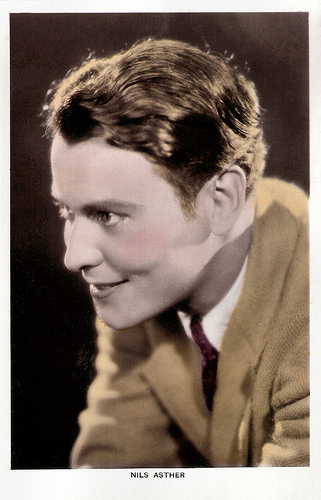
Nils Asther. British postcard in the Colourgraph Series, London, no. C 47.
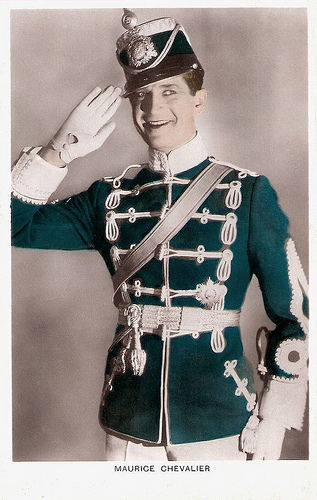
Maurice Chevalier . British postcard in the Colourgraph series, London, no. C 64.
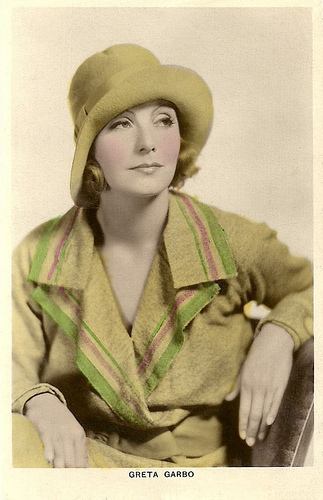
Greta Garbo . British postcard in the Colourgraph Series, London, no. C 81.
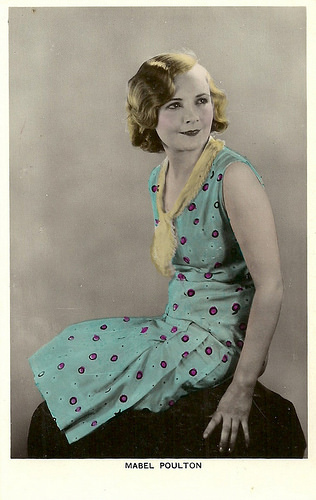
Mabel Poulton. British postcard in the Colourgraph Series, London, no. C 82.
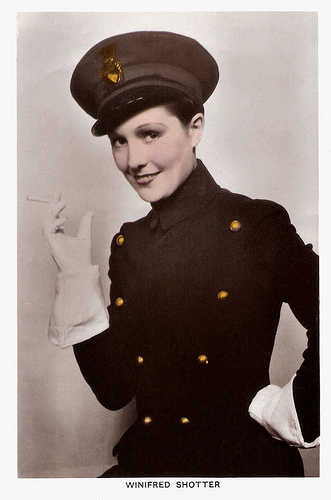
Winifred Shotter . British postcard in the Colourgraph Series, London, no. C 146.
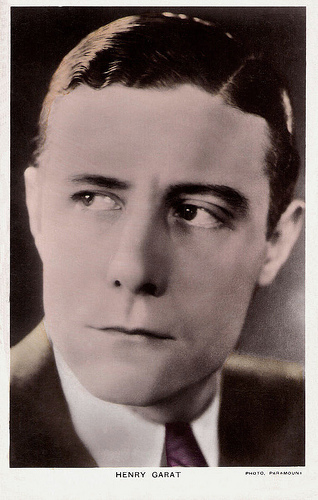
Henri Garat. British postcard in the Colourgraph Series, London, no. C 153. Photo: Paramount.
Picturegoer
In the 1920s and 1940s, each Picturegoer postcard measured 3-1/2" X 5-1/2", the regular postcard size. These were real photos with glossy finish on front.
On the back of each card is a number. The lettering after some of the numbers denotes the series that the card was from.
The postcards were issued in series, the first one, which ran to over 1400 cards, did not have any kind of prefix letter. The first series was followed by Series A, Series B, and Series C- the Colourgraph series.
Groups of several poses of the same star were sometimes published in this series and were identified with an alphabetical suffix. Subsequent series were given a prefix letter with the majority of images being in sepia tone.
Fo instance W stands for those postcards issued in the 1940s, D for the 1950s and S for the last series issued up to 1960.
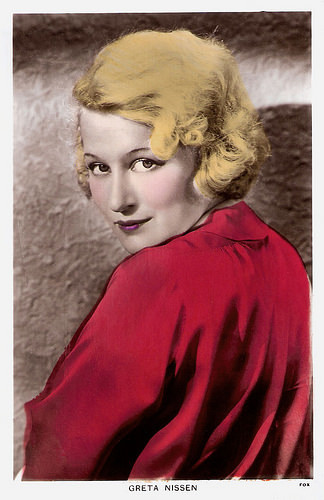
Greta Nissen . British postcard in the Colourgraph Series, London, no. C 184. Photo: Fox.
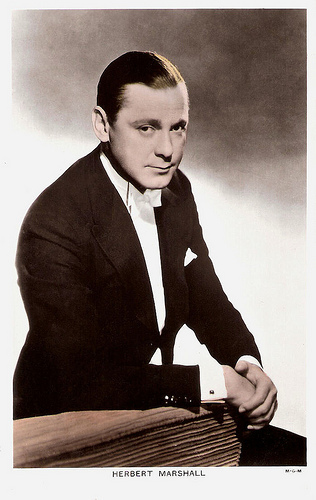
Herbert Marshall. British postcard in the Colourgraph Series, London, no. C 233. Photo: M.G.M.
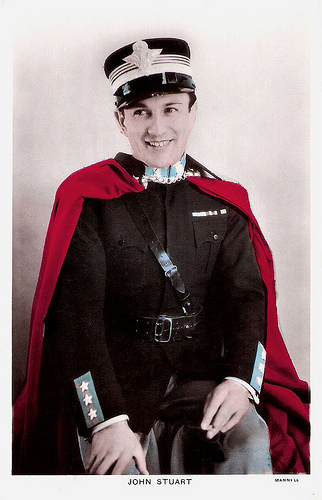
John Stuart . British postcard in the Colourgraph Series, London, no. C. 237. Photo: Mannell.
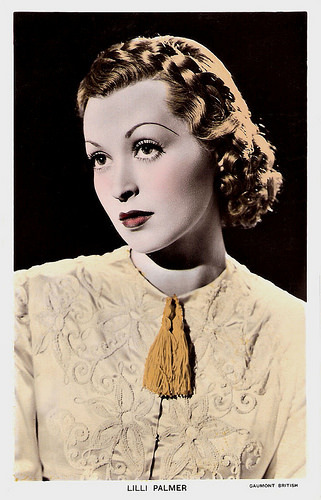
Lilli Palmer . British postcard in the Colourgraph Series, no. C 288. Photo: Gaumont British.
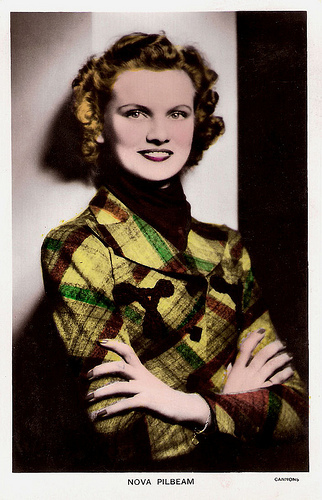
Nova Pilbeam . British postcard in the Colourgraph Series, no. C 332. Photo: Cannons.
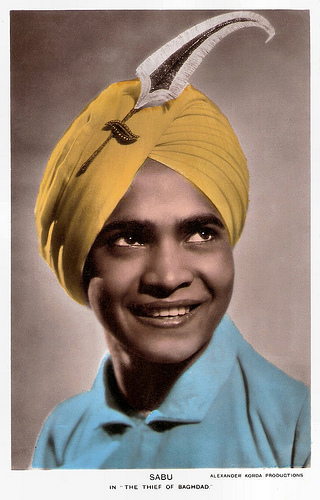
Sabu . British postcard in the Colourgraph Series, London, no. C. 338. Photo: Alexander Korda Productions. Publicity still for The Thief of Baghdad (Ludwig Berger, Michael Powell, Tim Whelan, 1940).
It is Postcard Friendship Friday, hosted by Beth at the The Best Hearts are Crunchy. You can visit her by clicking on the button below.


Nils Asther. British postcard in the Colourgraph Series, London, no. C 47.

Maurice Chevalier . British postcard in the Colourgraph series, London, no. C 64.

Greta Garbo . British postcard in the Colourgraph Series, London, no. C 81.

Mabel Poulton. British postcard in the Colourgraph Series, London, no. C 82.

Winifred Shotter . British postcard in the Colourgraph Series, London, no. C 146.

Henri Garat. British postcard in the Colourgraph Series, London, no. C 153. Photo: Paramount.
Picturegoer
In the 1920s and 1940s, each Picturegoer postcard measured 3-1/2" X 5-1/2", the regular postcard size. These were real photos with glossy finish on front.
On the back of each card is a number. The lettering after some of the numbers denotes the series that the card was from.
The postcards were issued in series, the first one, which ran to over 1400 cards, did not have any kind of prefix letter. The first series was followed by Series A, Series B, and Series C- the Colourgraph series.
Groups of several poses of the same star were sometimes published in this series and were identified with an alphabetical suffix. Subsequent series were given a prefix letter with the majority of images being in sepia tone.
Fo instance W stands for those postcards issued in the 1940s, D for the 1950s and S for the last series issued up to 1960.

Greta Nissen . British postcard in the Colourgraph Series, London, no. C 184. Photo: Fox.

Herbert Marshall. British postcard in the Colourgraph Series, London, no. C 233. Photo: M.G.M.

John Stuart . British postcard in the Colourgraph Series, London, no. C. 237. Photo: Mannell.

Lilli Palmer . British postcard in the Colourgraph Series, no. C 288. Photo: Gaumont British.

Nova Pilbeam . British postcard in the Colourgraph Series, no. C 332. Photo: Cannons.

Sabu . British postcard in the Colourgraph Series, London, no. C. 338. Photo: Alexander Korda Productions. Publicity still for The Thief of Baghdad (Ludwig Berger, Michael Powell, Tim Whelan, 1940).
It is Postcard Friendship Friday, hosted by Beth at the The Best Hearts are Crunchy. You can visit her by clicking on the button below.

Published on December 28, 2017 22:00
December 27, 2017
La bataille du rail (1946)
The French film La bataille du rail/The Battle of the Rails (René Clément, 1946) dealt with the courageous efforts of French railroad workers who were part of organized resistance during the Second World War. In 1944, the train workers derailed a train destined for German military transports. The Nazis killed hostages at a station as revenge. At the 1946 Cannes Film Festival the film won the International Jury Award, while René Clément won the Best Director Award.
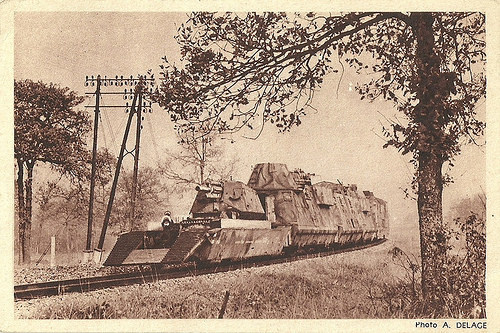
French postcard. Photo: A. Delage. Publicity still for La bataille du rail (René Clément, 1946).
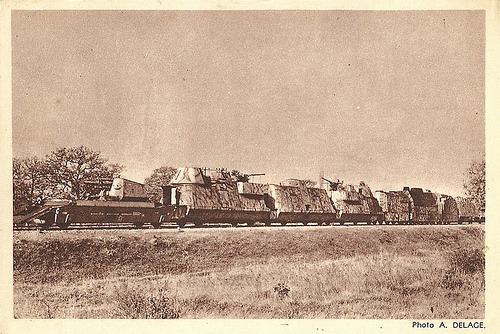
French postcard. Photo: A. Delage. Publicity still for La bataille du rail (René Clément, 1946).
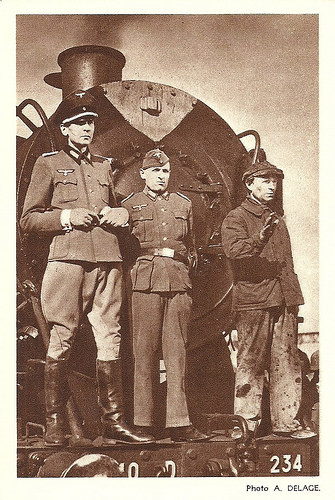
French postcard. Photo: A. Delage. Publicity still for La bataille du rail (René Clément, 1946).
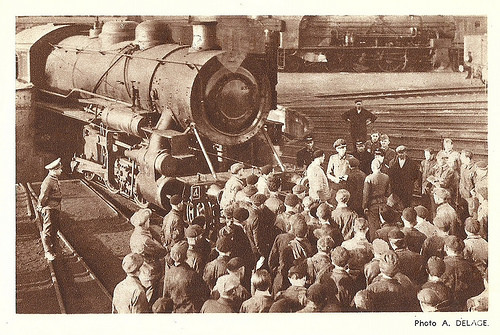
French postcard. Photo: A. Delage. Publicity still for La bataille du rail (René Clément, 1946).
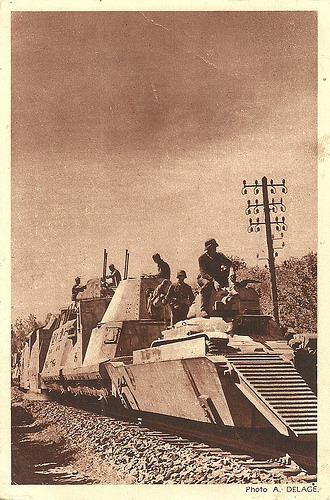
French postcard. Photo: A. Delage. Publicity still for La bataille du rail (René Clément, 1946).
Disrupting the German war machine
La bataille du rail/The Battle of the Rails (René Clément, 1946) was in part commissioned by the Associations of the Resistance soon after the end of the Second World War. 'La résistance' wanted to show international audiences what the French population had been facing under Nazi oppression.
The Resistance was also keen to let the world know that they had been actively involved in disrupting the German war machine in France as the international perception at the time was that the French had capitulated and collaborated a little too easily with their Nazi captors.
Based on real life events that occurred between the Normandy Landings and the liberation, when the French resistance frustrated the effort of the Nazis to use the rails to reinforce their army in many ways - ranging from sabotaging the tracks and equipment to even attacks on the trains themselves by partisans.
Johnek Bloomfield at IMDb : "Clément carefully avoids making the film too didactic or sentimental. We can see how the ruthlessness of the occupying forces in rooting out the saboteurs and their anti-Semitism is not overplayed as their portrayal seems appropriate to a modern audience not directly scarred by the events shown. Another way in which he achieves this is through the way the camera stays relatively detached from the action, showing the events almost like a documentary rather than forcing us to identify with any of the characters. It has been said that the cast was made up of unprofessional actors and in some cases real railwaymen. This adds to the realism and creates an effect where no one film star stands out as an obvious 'hero', enforcing a message of 'ordinary men doing what they had to'."
La bataille du rail was director René Clément's first feature. The film was shot on the actual locations with a cast of non-professional actors, who are all only referred to by their surnames in the opening credits. Cinematographer Henri Alekan actually had been a member of the Resistance, having escaped from a Nazi POW camp.
The film was a huge success in France when it premiered in 1946, one year after liberation. At the Cannes Film Festival, the film won the Prix international du jury and Clément won the Best Director Award. La bataille du rail also won the inaugural Prix Méliès.
However, La bataille du rail was quickly withdrawn from circulation, as it showed how to sabotage the railroads. At the time France was at war in Indochina and didn't want to feed the Việt Minh with ideas.
In 2010, La Bataille Du Rail/The Battle of the Rails was hailed as one of the classics of world cinema when it was shown in the Cannes Classics section during 63rd Cannes International Film Festival. It has been fully restored by INA in France.
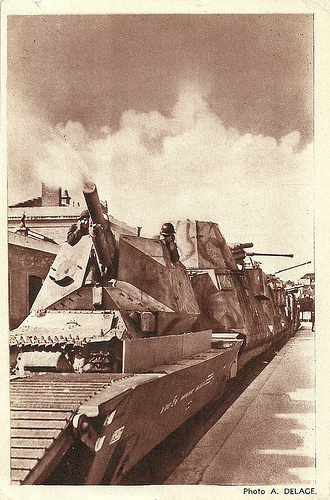
French postcard. Photo A. Delage. Publicity still for the French film La bataille du rail (René Clément, 1946). The film dealt with the courageous efforts during the Second World War of French train workers to derail a train destined for German military transports. The Germans kill hostages at a station as revenge.
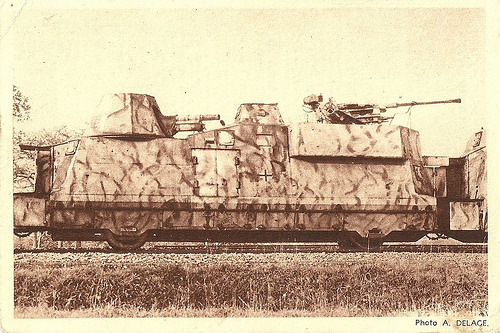
French postcard. Photo: A. Delage. Publicity still for La bataille du rail (René Clément, 1946).
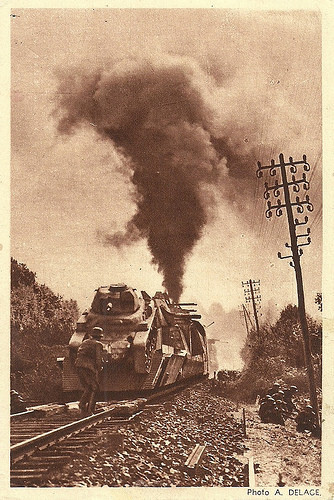
French postcard. Photo: A. Delage. Publicity still for La bataille du rail (René Clément, 1946).
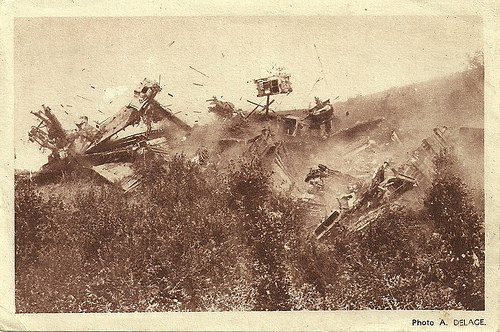
French postcard. Photo: A. Delage. Publicity still for La bataille du rail (René Clément, 1946).
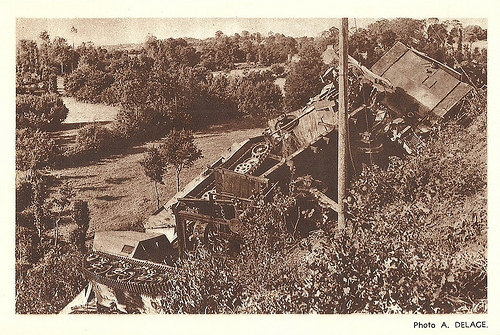
French postcard. Photo: A. Delage. Publicity still for La bataille du rail (René Clément, 1946).
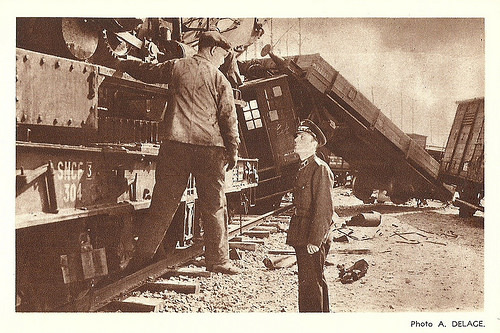
French postcard. Photo: A. Delage. Publicity still for La bataille du rail (René Clément, 1946).
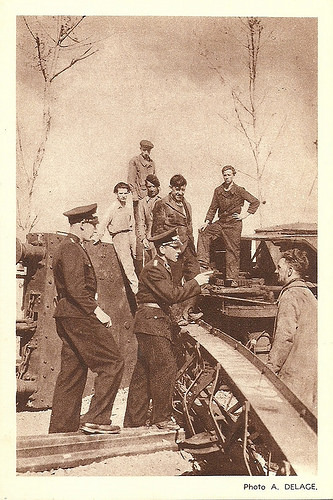
French postcard. Photo: A. Delage. Publicity still for La bataille du rail (René Clément, 1946).
Trailer La bataille du rail (René Clément, 1946). Source: Yves Lemerce (YouTube).
Sources: Johnek Bloomfield (IMDb), Wikipedia and IMDb.

French postcard. Photo: A. Delage. Publicity still for La bataille du rail (René Clément, 1946).

French postcard. Photo: A. Delage. Publicity still for La bataille du rail (René Clément, 1946).

French postcard. Photo: A. Delage. Publicity still for La bataille du rail (René Clément, 1946).

French postcard. Photo: A. Delage. Publicity still for La bataille du rail (René Clément, 1946).

French postcard. Photo: A. Delage. Publicity still for La bataille du rail (René Clément, 1946).
Disrupting the German war machine
La bataille du rail/The Battle of the Rails (René Clément, 1946) was in part commissioned by the Associations of the Resistance soon after the end of the Second World War. 'La résistance' wanted to show international audiences what the French population had been facing under Nazi oppression.
The Resistance was also keen to let the world know that they had been actively involved in disrupting the German war machine in France as the international perception at the time was that the French had capitulated and collaborated a little too easily with their Nazi captors.
Based on real life events that occurred between the Normandy Landings and the liberation, when the French resistance frustrated the effort of the Nazis to use the rails to reinforce their army in many ways - ranging from sabotaging the tracks and equipment to even attacks on the trains themselves by partisans.
Johnek Bloomfield at IMDb : "Clément carefully avoids making the film too didactic or sentimental. We can see how the ruthlessness of the occupying forces in rooting out the saboteurs and their anti-Semitism is not overplayed as their portrayal seems appropriate to a modern audience not directly scarred by the events shown. Another way in which he achieves this is through the way the camera stays relatively detached from the action, showing the events almost like a documentary rather than forcing us to identify with any of the characters. It has been said that the cast was made up of unprofessional actors and in some cases real railwaymen. This adds to the realism and creates an effect where no one film star stands out as an obvious 'hero', enforcing a message of 'ordinary men doing what they had to'."
La bataille du rail was director René Clément's first feature. The film was shot on the actual locations with a cast of non-professional actors, who are all only referred to by their surnames in the opening credits. Cinematographer Henri Alekan actually had been a member of the Resistance, having escaped from a Nazi POW camp.
The film was a huge success in France when it premiered in 1946, one year after liberation. At the Cannes Film Festival, the film won the Prix international du jury and Clément won the Best Director Award. La bataille du rail also won the inaugural Prix Méliès.
However, La bataille du rail was quickly withdrawn from circulation, as it showed how to sabotage the railroads. At the time France was at war in Indochina and didn't want to feed the Việt Minh with ideas.
In 2010, La Bataille Du Rail/The Battle of the Rails was hailed as one of the classics of world cinema when it was shown in the Cannes Classics section during 63rd Cannes International Film Festival. It has been fully restored by INA in France.

French postcard. Photo A. Delage. Publicity still for the French film La bataille du rail (René Clément, 1946). The film dealt with the courageous efforts during the Second World War of French train workers to derail a train destined for German military transports. The Germans kill hostages at a station as revenge.

French postcard. Photo: A. Delage. Publicity still for La bataille du rail (René Clément, 1946).

French postcard. Photo: A. Delage. Publicity still for La bataille du rail (René Clément, 1946).

French postcard. Photo: A. Delage. Publicity still for La bataille du rail (René Clément, 1946).

French postcard. Photo: A. Delage. Publicity still for La bataille du rail (René Clément, 1946).

French postcard. Photo: A. Delage. Publicity still for La bataille du rail (René Clément, 1946).

French postcard. Photo: A. Delage. Publicity still for La bataille du rail (René Clément, 1946).
Trailer La bataille du rail (René Clément, 1946). Source: Yves Lemerce (YouTube).
Sources: Johnek Bloomfield (IMDb), Wikipedia and IMDb.
Published on December 27, 2017 22:00
December 26, 2017
Atelier Manassé
Atelier Manassé was a legendary Austrian photo studio that captured the golden age of cinema and cabaret in Vienna of the 1920s and 1930s. The studio was founded by
Olga Spolarics and her
husband Adorján von Wlássics.
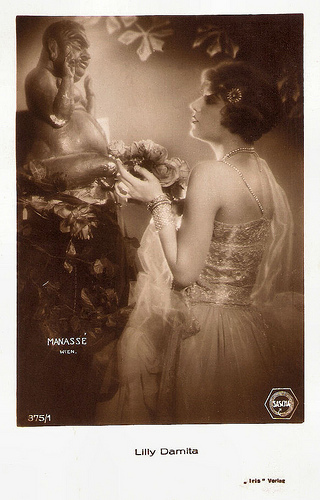
Lily Damita . Austrian postcard by Iris Verlag, no. 375/1. Photo: Manassé, Wien / Sascha. Publicity still for Das Spielzeug von Paris/Red Heels (Michael Kertesz a.k.a. Michael Curtis, 1925).
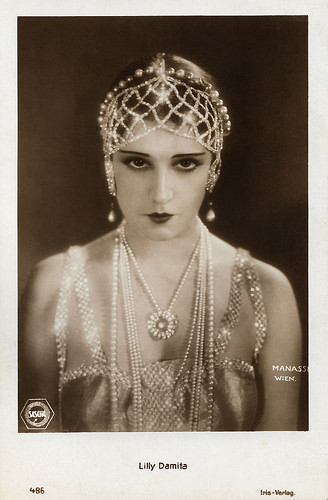
Lily Damita . Austrian postcard by Iris Verlag, no. 496. Photo: Manassé, Wien / Sascha. Publicity still for Das Spielzeug von Paris/Red Heels (Michael Kertesz a.k.a. Michael Curtis, 1925).
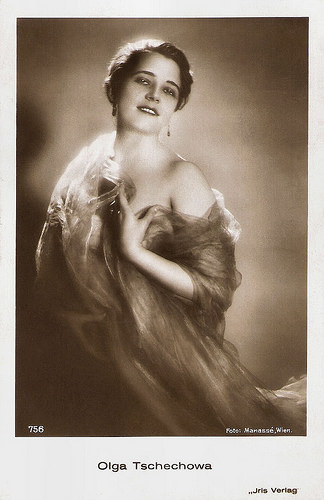
Olga Tschechova . Austrian postcard by Iris Verlag, no. 756. Photo: Manassé, Wien.
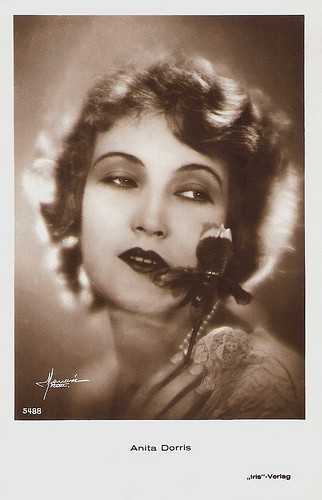
Anita Dorris . Austrian postcard by Iris-Verlag, no. 5488. Photo: Atelier Manassé.
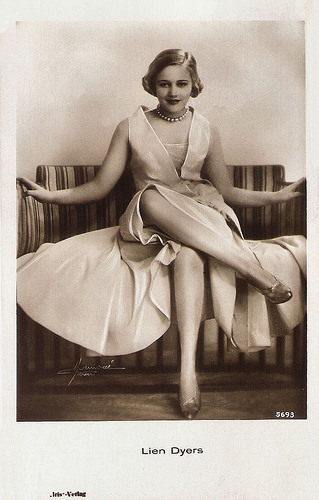
Lien Deyers . Austrian postcard by Iris Verlag, no. 5693. Photo: Manassé, Wien. Collection: Geoffrey Donaldson Instituut.
Glimpses Into the World of Glamour
Atelier Manassé, active from circa 1924 in Vienna and later also in Berlin, was founded by Adorján von Wlássics (1893-1946) and Olga Spolarics (1896-1969), both born in Hungary. Married in 1920, the Wlassics became part of Vienna’s high society, yet very little is known about their lives, education and training.
In the early 1920s, when the studio started, the film industry skyrocketed. From 1919 to 1922, the Austrian film studios like Sascha produced more than 140 films that found a global market. Popular variety shows flourished as well, bringing international stars such as Josephine Baker and the Tiller Girls, a popular British dance troupe, to Vienna.
Manassé's clients ran the gamut from magazine editors and advertising agencies to private buyers. Magazines aimed to satisfy a public obsessed with glimpses into the world of glamour. The Wlassics published their first film photos in publications like Wiener Magazin. The circa 30 magazines in Vienna needed images to accompany the increasing number of articles on film and theatre, in addition to gossip columns, sports news, fashion pieces and melodramatic stories of murder and mayhem.
Atelier Manassé started at the right time and the Wlassicas created masterpieces. They employed all the techniques of makeup, retouching, and over-painting to keep their subjects and buyers happy while upholding an uncompromised artistic vision. For us today, the studio’s rich visual legacy in part chronicles the golden era of cinema and theatre in Europe.
Kristine Somerville in her article Darkroom Alchemy: The Photographic Art of Studio Manassé at ResearchGate: "Styling, staging and photographic work was handled by Olga. She created the glamorous Manassé vision in their small but dazzling apartment, which also served as their studio in Vienna’s city center. The rooms and reception area were filled with lavish furnishings—bearskin rugs, Baroque furniture, tapestries, gilded mirrors, paintings and Greek pillars used as flower stands—which often appeared as backgrounds or props."
Somerville: "Adorján handled the artistic corrections and montages. He devoted a remarkable amount of time and ingenuity to perfecting techniques— primarily retouching, painting and overlaying images—to enhance Olga’s photographs."
Till 1938 many European but also Hollywood film stars and starlets were photographed in the Manassé studio. Rudolph Valentino , Anna May Wong , French Lily Damita , and the legendary La Jana were among the stars who were photographed by the Wlassics.
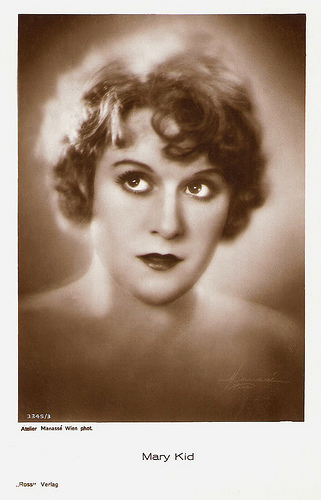
Mary Kid . German postcard by Ross Verlag, no. 3348/3, 1928-1929. Photo: Manassé, Wien.
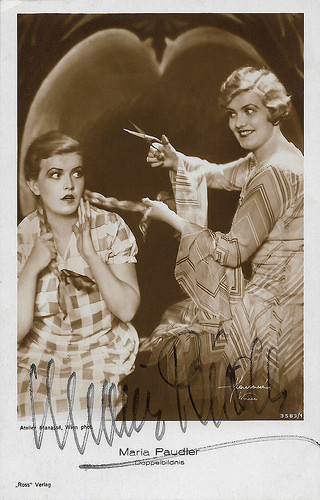
Maria Paudler . German postcard by Ross Verlag, no. 3583/1, 1928-1929. Photo: Manassé, Wien. Caption: Doppelbildnis (double portrait).
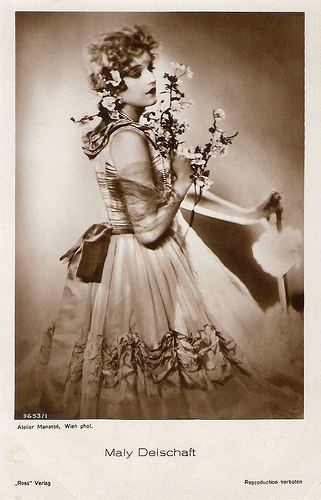
Maly Delschaft . German postcard by Ross Verlag, no. 3653/1, 1928-1929. Photo: Atelier Manassé, Wien.
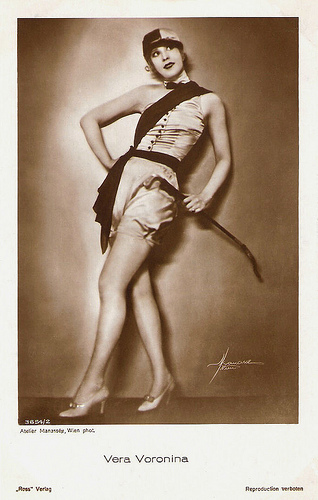
Vera Voronina . German postcard by Ross Verlag, no. 3654/2, 1928-1929. Photo: Atelier Manassé, Wien.
Nude Photography
Atelier Manassé also gained a high degree of popularity in the 1920s through erotic photographs, mainly of women.
Olga Spolarics (1896-1969) seems to have been the one interested in the nude photography. Atelier Manassé exhibited at the 1st International Salon of Nude Photography in Paris in 1933.
The artists liked to combine erotic with surreal motifs in their photographs. They used retouching techniques to create surreal and noir images that seethe with an erotic symbolism barely concealed beneath a mask of glorious styling, elegant poses, and extravagant costumes.
In 1934, an entire edition of Muskete, a humorous magazine known for its caricature and pictorial jokes, was confiscated by Austrian censors. The Wlassics had failed to remove in the darkroom all traces of pubic hair on their nude cover photo.
The cover picture was one of their 'photographic jokes'. This genre was popularised by postcards that employed trick photography to depict such images as pretty girls growing on trees, the cherubic face of a loved one appearing in a wreath of pipe smoke or a lithe young woman hanging seductively from a businessman’s necktie.
The Wlassics went back to their studio and amended the photo, and the next month the magazine was republished without issue.
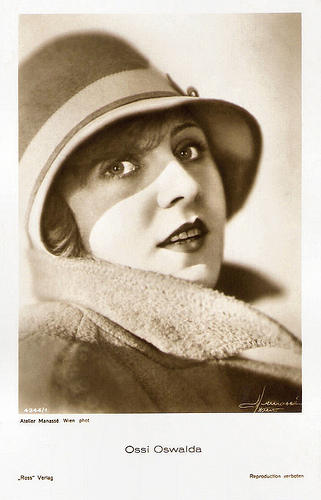
Ossi Oswalda . German postcard by Ross Verlag, no. 4244/1, 1929-1930. Photo: Atelier Manassé, Wien.
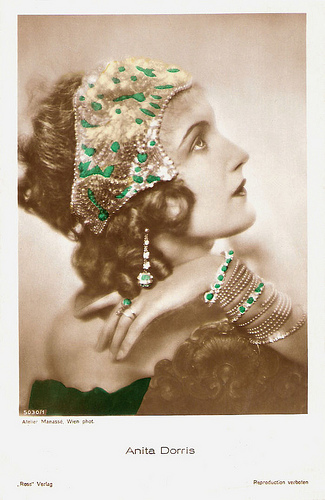
Anita Dorris . German postcard by Ross Verlag, no. 5030/1, 1930-1931. Photo: Manassé, Wien.
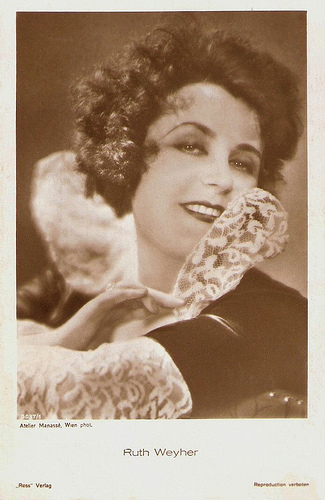
Ruth Weyher . German postcard by Ross Verlag, no. 5037/1, 1930-1931. Photo: Atelier Manassé, Wien.
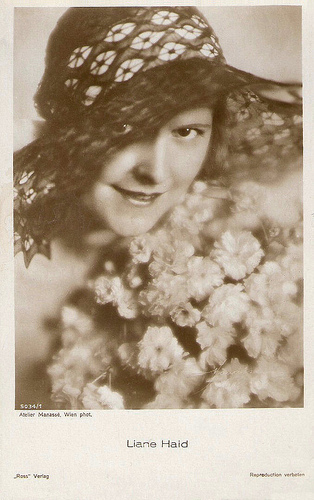
Liane Haid . German postcard by Ross Verlag, no. 5034/1, 1930-1931. Photo: Manassé, Wien (Vienna).
Divas and lovers
When Adorján von Wlássics and Olga Spolarics opened a new, smaller studio in Berlin, their business in Vienna was managed more and more by an associate.
They operated under various names, including Wlasics (the first name of the studio), WOG (in their Berlin studio) and Manassé-Ricoll (after the studio in Vienna was operated by an associate).
After the death of Adorján von Wlassics in 1947, the fame of the studio faded. Olga remarried and died in 1969.
In 1998 their photos were rediscovered through the publication Divas and lovers: the erotic art of Studio Manassé, by photographic historian Monika Faber, curator in the department of drawing and photography in the Museum of Modern Art in Vienna.
Billyjane & Drake Caperton regularly post pictures of Atelier Manassé on Facebook and Tumblr.
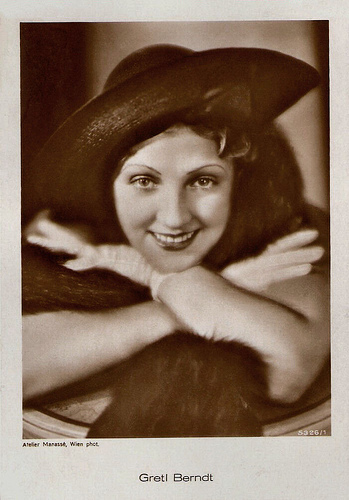
Gretl Berndt . German postcard by Ross Verlag, no. 5326/1, 1930-1931. Photo: Atelier Manassé, Wien.
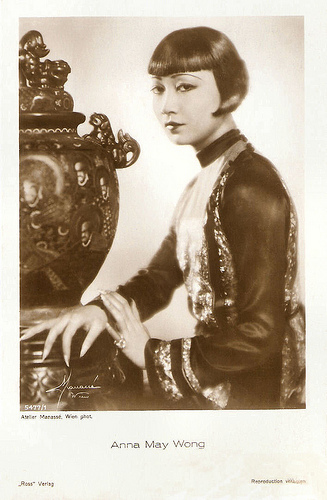
Anna May Wong . German postcard by Ross Verlag, no. 5477/1, 1930-1931. Photo: Atelier Manassé, Wien (Vienna).
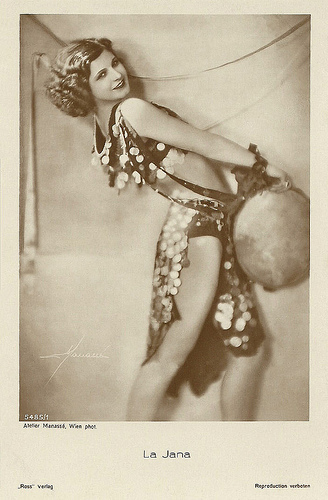
La Jana. German postcard by Ross Verlag, no. 5485/1, 1930-1931. Photo: Atelier Manassé, Wien. Collection: Didier Hanson.
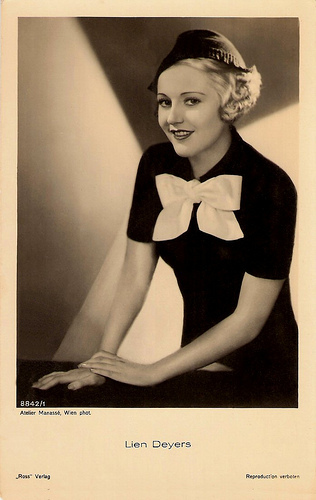
Lien Deyers . German postcard by Ross Verlag, no. 8842/1, 1933-1934. Photo: Atelier Manassé, Wien.
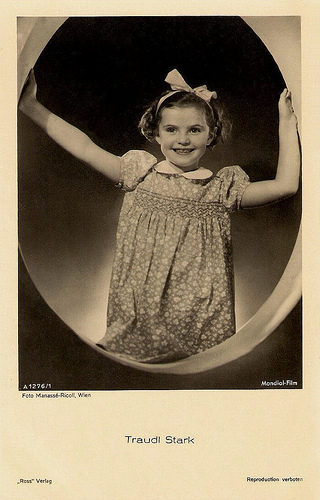
Traudl Stark . German postcard by Ross Verlag, no. A 1276/1, 1937-1938. Photo: Manassé-Ricoll, Wien / Mondial-Film.
Sources: Monika Faber (Divas and Lovers), Kristine Somerville (Darkroom Alchemy - ResearchGate), Billyjane & Drake Caperton (Facebook and Tumblr - Studio Manasse), Historical Ziegfield Group and Wikipedia (German).

Lily Damita . Austrian postcard by Iris Verlag, no. 375/1. Photo: Manassé, Wien / Sascha. Publicity still for Das Spielzeug von Paris/Red Heels (Michael Kertesz a.k.a. Michael Curtis, 1925).

Lily Damita . Austrian postcard by Iris Verlag, no. 496. Photo: Manassé, Wien / Sascha. Publicity still for Das Spielzeug von Paris/Red Heels (Michael Kertesz a.k.a. Michael Curtis, 1925).

Olga Tschechova . Austrian postcard by Iris Verlag, no. 756. Photo: Manassé, Wien.

Anita Dorris . Austrian postcard by Iris-Verlag, no. 5488. Photo: Atelier Manassé.

Lien Deyers . Austrian postcard by Iris Verlag, no. 5693. Photo: Manassé, Wien. Collection: Geoffrey Donaldson Instituut.
Glimpses Into the World of Glamour
Atelier Manassé, active from circa 1924 in Vienna and later also in Berlin, was founded by Adorján von Wlássics (1893-1946) and Olga Spolarics (1896-1969), both born in Hungary. Married in 1920, the Wlassics became part of Vienna’s high society, yet very little is known about their lives, education and training.
In the early 1920s, when the studio started, the film industry skyrocketed. From 1919 to 1922, the Austrian film studios like Sascha produced more than 140 films that found a global market. Popular variety shows flourished as well, bringing international stars such as Josephine Baker and the Tiller Girls, a popular British dance troupe, to Vienna.
Manassé's clients ran the gamut from magazine editors and advertising agencies to private buyers. Magazines aimed to satisfy a public obsessed with glimpses into the world of glamour. The Wlassics published their first film photos in publications like Wiener Magazin. The circa 30 magazines in Vienna needed images to accompany the increasing number of articles on film and theatre, in addition to gossip columns, sports news, fashion pieces and melodramatic stories of murder and mayhem.
Atelier Manassé started at the right time and the Wlassicas created masterpieces. They employed all the techniques of makeup, retouching, and over-painting to keep their subjects and buyers happy while upholding an uncompromised artistic vision. For us today, the studio’s rich visual legacy in part chronicles the golden era of cinema and theatre in Europe.
Kristine Somerville in her article Darkroom Alchemy: The Photographic Art of Studio Manassé at ResearchGate: "Styling, staging and photographic work was handled by Olga. She created the glamorous Manassé vision in their small but dazzling apartment, which also served as their studio in Vienna’s city center. The rooms and reception area were filled with lavish furnishings—bearskin rugs, Baroque furniture, tapestries, gilded mirrors, paintings and Greek pillars used as flower stands—which often appeared as backgrounds or props."
Somerville: "Adorján handled the artistic corrections and montages. He devoted a remarkable amount of time and ingenuity to perfecting techniques— primarily retouching, painting and overlaying images—to enhance Olga’s photographs."
Till 1938 many European but also Hollywood film stars and starlets were photographed in the Manassé studio. Rudolph Valentino , Anna May Wong , French Lily Damita , and the legendary La Jana were among the stars who were photographed by the Wlassics.

Mary Kid . German postcard by Ross Verlag, no. 3348/3, 1928-1929. Photo: Manassé, Wien.

Maria Paudler . German postcard by Ross Verlag, no. 3583/1, 1928-1929. Photo: Manassé, Wien. Caption: Doppelbildnis (double portrait).

Maly Delschaft . German postcard by Ross Verlag, no. 3653/1, 1928-1929. Photo: Atelier Manassé, Wien.

Vera Voronina . German postcard by Ross Verlag, no. 3654/2, 1928-1929. Photo: Atelier Manassé, Wien.
Nude Photography
Atelier Manassé also gained a high degree of popularity in the 1920s through erotic photographs, mainly of women.
Olga Spolarics (1896-1969) seems to have been the one interested in the nude photography. Atelier Manassé exhibited at the 1st International Salon of Nude Photography in Paris in 1933.
The artists liked to combine erotic with surreal motifs in their photographs. They used retouching techniques to create surreal and noir images that seethe with an erotic symbolism barely concealed beneath a mask of glorious styling, elegant poses, and extravagant costumes.
In 1934, an entire edition of Muskete, a humorous magazine known for its caricature and pictorial jokes, was confiscated by Austrian censors. The Wlassics had failed to remove in the darkroom all traces of pubic hair on their nude cover photo.
The cover picture was one of their 'photographic jokes'. This genre was popularised by postcards that employed trick photography to depict such images as pretty girls growing on trees, the cherubic face of a loved one appearing in a wreath of pipe smoke or a lithe young woman hanging seductively from a businessman’s necktie.
The Wlassics went back to their studio and amended the photo, and the next month the magazine was republished without issue.

Ossi Oswalda . German postcard by Ross Verlag, no. 4244/1, 1929-1930. Photo: Atelier Manassé, Wien.

Anita Dorris . German postcard by Ross Verlag, no. 5030/1, 1930-1931. Photo: Manassé, Wien.

Ruth Weyher . German postcard by Ross Verlag, no. 5037/1, 1930-1931. Photo: Atelier Manassé, Wien.

Liane Haid . German postcard by Ross Verlag, no. 5034/1, 1930-1931. Photo: Manassé, Wien (Vienna).
Divas and lovers
When Adorján von Wlássics and Olga Spolarics opened a new, smaller studio in Berlin, their business in Vienna was managed more and more by an associate.
They operated under various names, including Wlasics (the first name of the studio), WOG (in their Berlin studio) and Manassé-Ricoll (after the studio in Vienna was operated by an associate).
After the death of Adorján von Wlassics in 1947, the fame of the studio faded. Olga remarried and died in 1969.
In 1998 their photos were rediscovered through the publication Divas and lovers: the erotic art of Studio Manassé, by photographic historian Monika Faber, curator in the department of drawing and photography in the Museum of Modern Art in Vienna.
Billyjane & Drake Caperton regularly post pictures of Atelier Manassé on Facebook and Tumblr.

Gretl Berndt . German postcard by Ross Verlag, no. 5326/1, 1930-1931. Photo: Atelier Manassé, Wien.

Anna May Wong . German postcard by Ross Verlag, no. 5477/1, 1930-1931. Photo: Atelier Manassé, Wien (Vienna).

La Jana. German postcard by Ross Verlag, no. 5485/1, 1930-1931. Photo: Atelier Manassé, Wien. Collection: Didier Hanson.

Lien Deyers . German postcard by Ross Verlag, no. 8842/1, 1933-1934. Photo: Atelier Manassé, Wien.

Traudl Stark . German postcard by Ross Verlag, no. A 1276/1, 1937-1938. Photo: Manassé-Ricoll, Wien / Mondial-Film.
Sources: Monika Faber (Divas and Lovers), Kristine Somerville (Darkroom Alchemy - ResearchGate), Billyjane & Drake Caperton (Facebook and Tumblr - Studio Manasse), Historical Ziegfield Group and Wikipedia (German).
Published on December 26, 2017 22:00
December 25, 2017
Harry Piel
German ‘dynamite’ director, actor, producer and screenwriter Harry Piel (1892-1963) made over 150 sensational films full of explosions and stunts. With his iron nerves, he was Tom Mix, Douglas Fairbanks and Eddy Polo, all in one person.
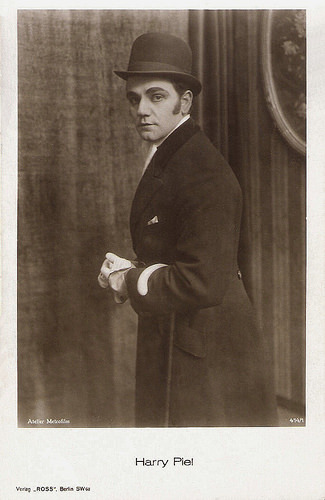
German postcard by Ross Verlag, Berlin, no. 414/1, 1919-1924. Photo: Atelier Metrofilm.
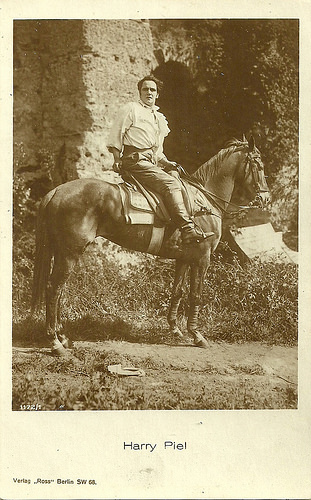
German postcard by Ross Verlag, no. 1172/1, 1927-1928. Photo: publicity still for the German-French co-production Zigano (Harry Piel, Gerard Bourgeois, 1925), for which the exteriors were shot in Rome.
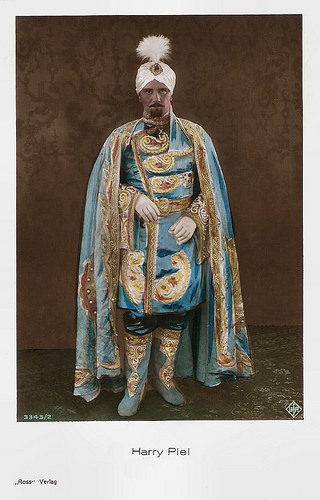
German postcard by Ross Verlag, no. 3343/2, 1928-1929. Photo: Ufa. Publicity still for Panik/Panic (Harry Piel, 1928), in which Piel plays Mister X, alias Harry Peel, alias The Rajah of Lahore.
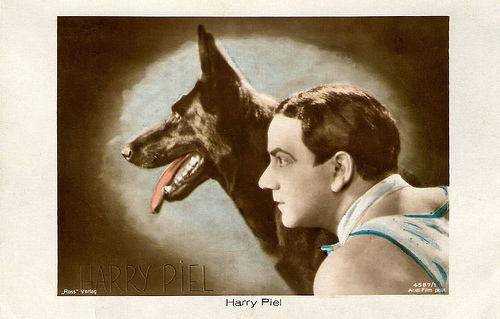
German postcard by Ross Verlag, Berlin, no. 4587/1, 1929-1930. Photo: Ariel-Film. Piel worked for Ariel-Film GmbH from 1928 till 1938. Publicity still for Sein bester Freund/His Best Friend (Harry Piel, 1929).
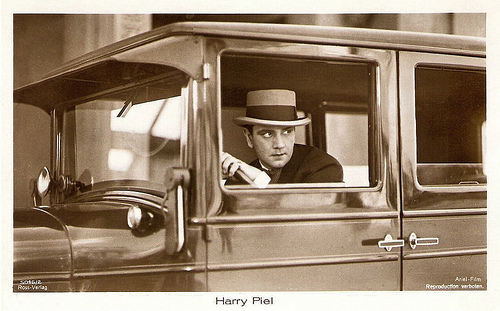
German postcard by Ross Verlag, no. 5046/2, 1930-1931. Photo: Ariel-Film. In 1930, Harry Piel produced and directed Achtung! Auto-Diebe!/Attention! Car Thieves! (Harry Piel, 1930). It was his last silent film.
The dynamite director
Hubert August Piel was born in Düsseldorf, Germany in 1892, as the son of an innkeeper and a farmer's daughter.
His career started already adventurous. After attending elementary school in Benrath and secondary school in Düsseldorf, Piel became a cadet in 1909 on a sail training ship, the Grand Duchess Elizabeth, but seven months later, he was sent back home because of a heart failure.
He started a commercial apprenticeship, did some odd jobs including working in a circus, and studied several foreign languages. In 1911 he went to Paris to become a stunt pilot.
In France, he met director Léonce Perret, who introduced him to Gaumont. There he wrote his first script and the cinema became his passion.
In 1912 he moved to Berlin where he founded his first film company, the Kunst-Film-Verlags-GmbH. His debut as a director-writer-producer was the adventure film Schwarzes Blut/Black Blood (Harry Piel, 1912) starring Curt Goetz. Even though his company went bankrupt, Piel had become established.
In the following years he shot dozens of short films full of action and adventure such as Der Triumph des Todes/The triumph of the death (Harry Piel, 1912), Ein Millionenraub/A million robbery (Harry Piel, 1914), and Die grosse Wette/The Large Bet (Harry Piel, 1916), all starring Ludwig Trautmann .
As a director he had the nickname ‘the dynamite director’ because of all the exploding bridges and houses in his films. These explosions were often authentic. A demolition engineer notified him about forthcoming blow ups. He filmed the explosions and inserted the footage into his films.
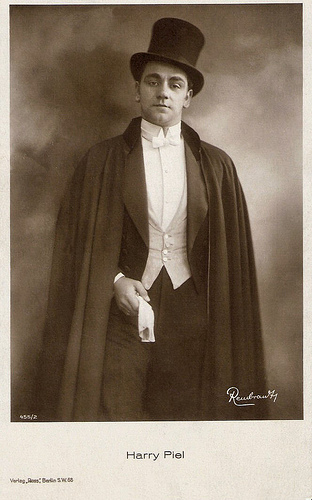
German postcard by Ross Verlag, Berlin, no. 455/2, 1919-1924. Photo: Rembrandt.
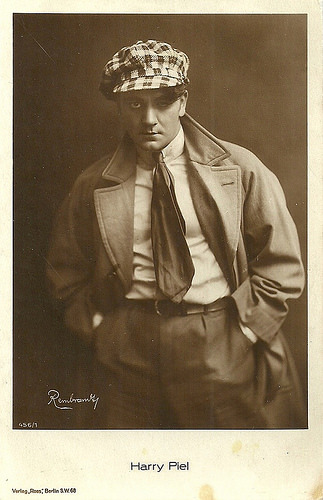
German postcard by Ross Verlag, Berlin, no. 456/1, 1919-1924. Photo: Rembrandt.
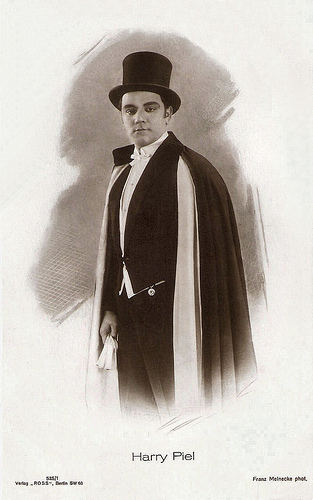
German postcard by Ross Verlag, Berlin, no. 525/1, 1919-1924. Photo: Franz Meinecke, Berlin.
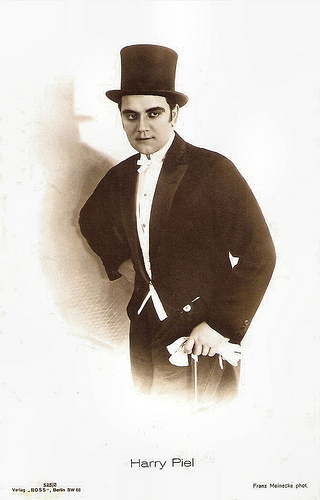
German postcard by Ross Verlag, Berlin, no. 525/2, 1919-1924. Photo: Franz Meinecke, Berlin.
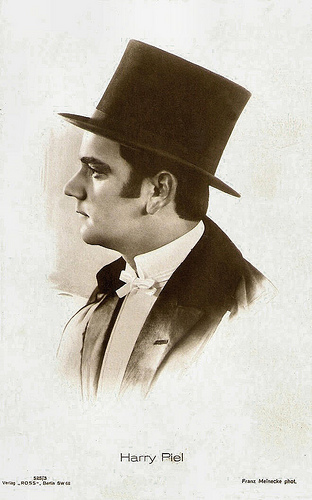
German postcard by Ross Verlag, Berlin, no. 525/3, 1919-1924. Photo: Franz Meinecke, Berlin.
Joe Deebs, Private Investigator
In 1915, Harry Piel became too bored with just standing behind the lens and he started to act before the camera. His first film as a leading actor, Die große Wette/The Large Bet (Harry Piel, 1916), was a science fiction film on the subject of man-machines.
In Unter heißer Zone/Under the Hot Sun (Harry Piel, 1916) he used scenes with wild animals for the first time. He pretended that he did all his stunts himself, but the most dangerous stunts were carried out by Hermann Stetza.
During 1918 and 1919, Piel directed and starred in eight films of the Joe Deebs, private investigator series. Internationally he became a popular film star under the name of Harry Peel.
In 1927 he starred in a double role alongside Marlene Dietrich in Sein größter Bluff/His Greatest Bluff (Henrik Galeen, Harry Piel, 1927).
That same year he married actress Dary Holm, who appeared in several of his films.
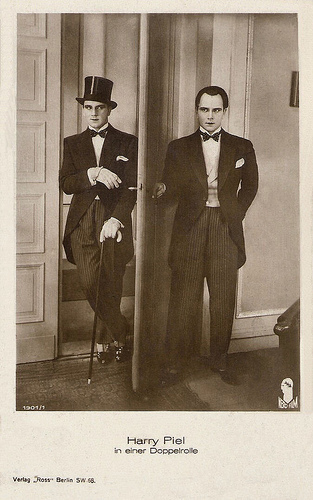
German postcard by Ross Verlag, Berlin, no. 1901/1, 1927-1928. Photo: Nero Film. Piel played twin brothers in Sein grösster Bluff/His Greatest Bluff (Harry Piel, 1927).
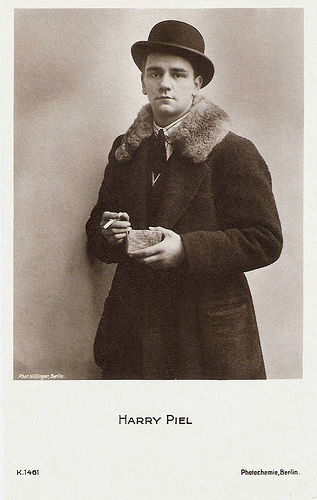
German postcard by Photochemie, Berlin, K 1481. Photo: Willinger, Berlin.
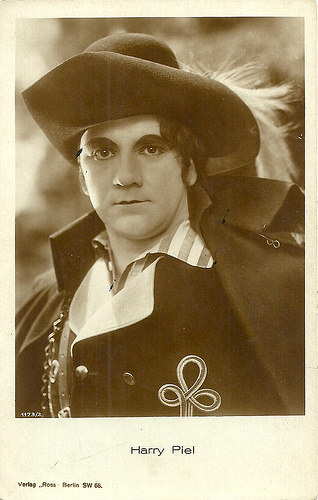
German postcard by Ross Verlag, Berlin, no. 1173/2, 1927-28. Photo: still for Zigano (Harry Piel, Gérard Bourgeois, 1925).
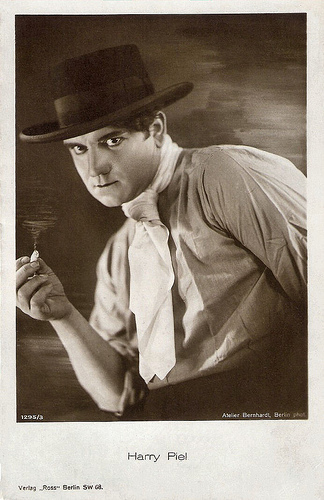
German postcard by Ross Verlag, Berlin, no. 1295/3, 1927-1928. Photo: Atelier Bernhardt, Berlin.
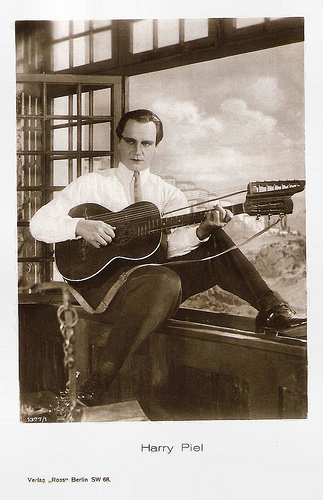
German postcard by Ross Verlag, Berlin, no. 1377/1, 1927-1928.
Doppelganger
Effortlessly Harry Piel changed to sound film in the doppelganger comedy Er oder ich/Him or Me (Harry Piel, 1930) with Valerie Boothby .
Many adventure films followed, such as the box-office hits Schatten der Unterwelt/Shade of the Underworld (Harry Piel, 1931) with Elisabeth Pinajeff , Jonny stiehlt Europa/Johnny Steals Europe (Andrew Marton, Harry Piel, 1932) with Alfred Abel , and Der Dschungel ruft/The Call of the Jungle (Harry Piel, 1935) with Gerda Maurus .
Difficulties began with Panik/Panic (Harry Piel, 1940-1943), about an animal catcher who works for German zoos. At the film's climax, an air-raid on a German city frees the wild animals in the zoo and only the heroic trapper can recapture them. The authorities found the air strikes too realistic and did not want the public to believe that Germany was in danger, so the film was forbidden.
Furthermore his production company, Ariel Film Co., was liquidated through the nationalisation and 72 negatives of his films, nearly all silent films, were destroyed with an air strike.
He was a sustaining member of the NSDAP (the Nazi party), and after the war he first concealed this to his enquirers. He was sentenced to six months detention and five years professional disqualification.
After his denazification in 1950, he refounded Ariel Film. His last directorial effort was Gesprengte Gitter/Elephant Fury (Harry Piel, 1953) with Dorothea Wieck , which was based on Panik. However it had only moderate success.
Piel gave up Ariel-film in 1960 and retired. Harry Piel died in Munich, Germany in 1963.
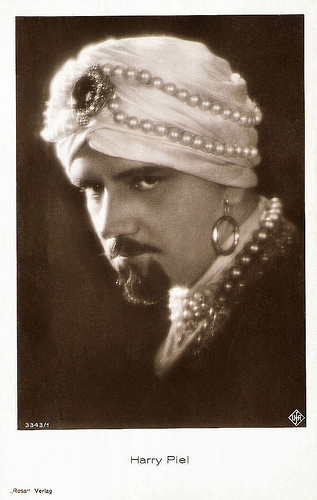
German postcard by Ross Verlag, no. 3343/1, 1928-1929. Photo: Ufa. Publicity still for Panik/Panic (Harry Piel, 1928).
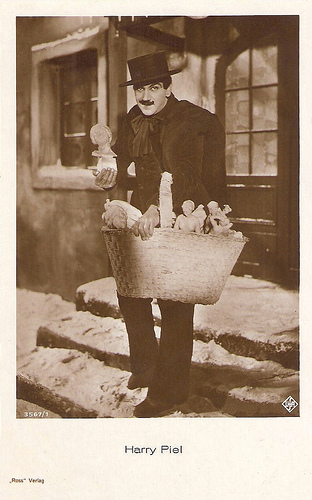
German postcard by Ross Verlag, no. 3567/1, 1928-1929. Photo: Ufa.
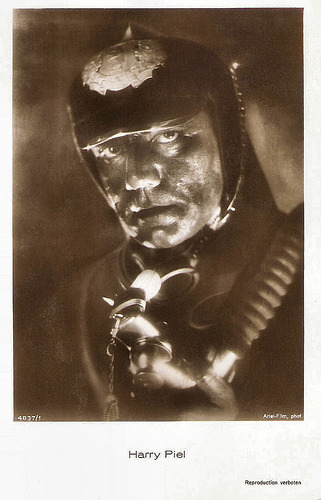
German postcard by Ross Verlag, Berlin, no. 4837/1, 1929-1930. Photo: Ariel-Film. Publicity still for Menschen im Feuer (Harry Piel, 1930).
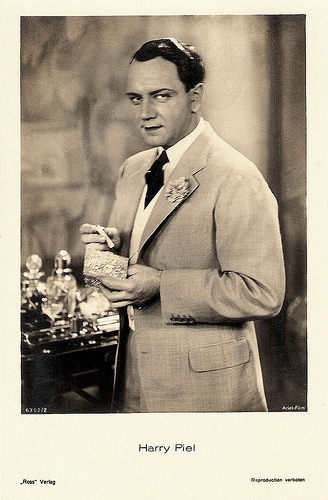
German postcard by Ross Verlag, no. 6302/2, 1931-1932. Photo: Ariel-Film.
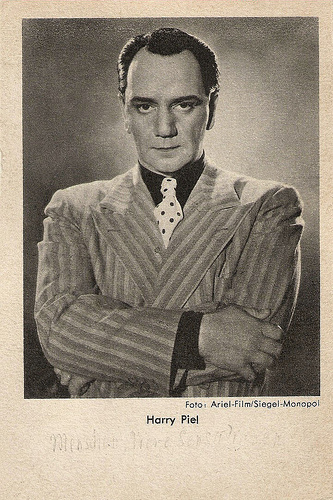
German postcard. Photo: Ariel-Film / Siegel-Monopol.
Sources: Thomas Staedeli (Cyranos), Stephanie D'heil (Steffi-Line) (German), Wikipedia, Filmportal.de and .

German postcard by Ross Verlag, Berlin, no. 414/1, 1919-1924. Photo: Atelier Metrofilm.

German postcard by Ross Verlag, no. 1172/1, 1927-1928. Photo: publicity still for the German-French co-production Zigano (Harry Piel, Gerard Bourgeois, 1925), for which the exteriors were shot in Rome.

German postcard by Ross Verlag, no. 3343/2, 1928-1929. Photo: Ufa. Publicity still for Panik/Panic (Harry Piel, 1928), in which Piel plays Mister X, alias Harry Peel, alias The Rajah of Lahore.

German postcard by Ross Verlag, Berlin, no. 4587/1, 1929-1930. Photo: Ariel-Film. Piel worked for Ariel-Film GmbH from 1928 till 1938. Publicity still for Sein bester Freund/His Best Friend (Harry Piel, 1929).

German postcard by Ross Verlag, no. 5046/2, 1930-1931. Photo: Ariel-Film. In 1930, Harry Piel produced and directed Achtung! Auto-Diebe!/Attention! Car Thieves! (Harry Piel, 1930). It was his last silent film.
The dynamite director
Hubert August Piel was born in Düsseldorf, Germany in 1892, as the son of an innkeeper and a farmer's daughter.
His career started already adventurous. After attending elementary school in Benrath and secondary school in Düsseldorf, Piel became a cadet in 1909 on a sail training ship, the Grand Duchess Elizabeth, but seven months later, he was sent back home because of a heart failure.
He started a commercial apprenticeship, did some odd jobs including working in a circus, and studied several foreign languages. In 1911 he went to Paris to become a stunt pilot.
In France, he met director Léonce Perret, who introduced him to Gaumont. There he wrote his first script and the cinema became his passion.
In 1912 he moved to Berlin where he founded his first film company, the Kunst-Film-Verlags-GmbH. His debut as a director-writer-producer was the adventure film Schwarzes Blut/Black Blood (Harry Piel, 1912) starring Curt Goetz. Even though his company went bankrupt, Piel had become established.
In the following years he shot dozens of short films full of action and adventure such as Der Triumph des Todes/The triumph of the death (Harry Piel, 1912), Ein Millionenraub/A million robbery (Harry Piel, 1914), and Die grosse Wette/The Large Bet (Harry Piel, 1916), all starring Ludwig Trautmann .
As a director he had the nickname ‘the dynamite director’ because of all the exploding bridges and houses in his films. These explosions were often authentic. A demolition engineer notified him about forthcoming blow ups. He filmed the explosions and inserted the footage into his films.

German postcard by Ross Verlag, Berlin, no. 455/2, 1919-1924. Photo: Rembrandt.

German postcard by Ross Verlag, Berlin, no. 456/1, 1919-1924. Photo: Rembrandt.

German postcard by Ross Verlag, Berlin, no. 525/1, 1919-1924. Photo: Franz Meinecke, Berlin.

German postcard by Ross Verlag, Berlin, no. 525/2, 1919-1924. Photo: Franz Meinecke, Berlin.

German postcard by Ross Verlag, Berlin, no. 525/3, 1919-1924. Photo: Franz Meinecke, Berlin.
Joe Deebs, Private Investigator
In 1915, Harry Piel became too bored with just standing behind the lens and he started to act before the camera. His first film as a leading actor, Die große Wette/The Large Bet (Harry Piel, 1916), was a science fiction film on the subject of man-machines.
In Unter heißer Zone/Under the Hot Sun (Harry Piel, 1916) he used scenes with wild animals for the first time. He pretended that he did all his stunts himself, but the most dangerous stunts were carried out by Hermann Stetza.
During 1918 and 1919, Piel directed and starred in eight films of the Joe Deebs, private investigator series. Internationally he became a popular film star under the name of Harry Peel.
In 1927 he starred in a double role alongside Marlene Dietrich in Sein größter Bluff/His Greatest Bluff (Henrik Galeen, Harry Piel, 1927).
That same year he married actress Dary Holm, who appeared in several of his films.

German postcard by Ross Verlag, Berlin, no. 1901/1, 1927-1928. Photo: Nero Film. Piel played twin brothers in Sein grösster Bluff/His Greatest Bluff (Harry Piel, 1927).

German postcard by Photochemie, Berlin, K 1481. Photo: Willinger, Berlin.

German postcard by Ross Verlag, Berlin, no. 1173/2, 1927-28. Photo: still for Zigano (Harry Piel, Gérard Bourgeois, 1925).

German postcard by Ross Verlag, Berlin, no. 1295/3, 1927-1928. Photo: Atelier Bernhardt, Berlin.

German postcard by Ross Verlag, Berlin, no. 1377/1, 1927-1928.
Doppelganger
Effortlessly Harry Piel changed to sound film in the doppelganger comedy Er oder ich/Him or Me (Harry Piel, 1930) with Valerie Boothby .
Many adventure films followed, such as the box-office hits Schatten der Unterwelt/Shade of the Underworld (Harry Piel, 1931) with Elisabeth Pinajeff , Jonny stiehlt Europa/Johnny Steals Europe (Andrew Marton, Harry Piel, 1932) with Alfred Abel , and Der Dschungel ruft/The Call of the Jungle (Harry Piel, 1935) with Gerda Maurus .
Difficulties began with Panik/Panic (Harry Piel, 1940-1943), about an animal catcher who works for German zoos. At the film's climax, an air-raid on a German city frees the wild animals in the zoo and only the heroic trapper can recapture them. The authorities found the air strikes too realistic and did not want the public to believe that Germany was in danger, so the film was forbidden.
Furthermore his production company, Ariel Film Co., was liquidated through the nationalisation and 72 negatives of his films, nearly all silent films, were destroyed with an air strike.
He was a sustaining member of the NSDAP (the Nazi party), and after the war he first concealed this to his enquirers. He was sentenced to six months detention and five years professional disqualification.
After his denazification in 1950, he refounded Ariel Film. His last directorial effort was Gesprengte Gitter/Elephant Fury (Harry Piel, 1953) with Dorothea Wieck , which was based on Panik. However it had only moderate success.
Piel gave up Ariel-film in 1960 and retired. Harry Piel died in Munich, Germany in 1963.

German postcard by Ross Verlag, no. 3343/1, 1928-1929. Photo: Ufa. Publicity still for Panik/Panic (Harry Piel, 1928).

German postcard by Ross Verlag, no. 3567/1, 1928-1929. Photo: Ufa.

German postcard by Ross Verlag, Berlin, no. 4837/1, 1929-1930. Photo: Ariel-Film. Publicity still for Menschen im Feuer (Harry Piel, 1930).

German postcard by Ross Verlag, no. 6302/2, 1931-1932. Photo: Ariel-Film.

German postcard. Photo: Ariel-Film / Siegel-Monopol.
Sources: Thomas Staedeli (Cyranos), Stephanie D'heil (Steffi-Line) (German), Wikipedia, Filmportal.de and .
Published on December 25, 2017 22:00
December 24, 2017
Merry Christmas!
As every year: Gelukkig kerstfeest! Frohe Weihnachten! ¡Feliz Navidad! Joyeux Noël! Buon Natale! Sretan Božić! Καλά Χριστούγεννα! Boldog karácsonyt! Gleðileg jól! Nollaig Shona! Priecīgus Ziemassvētkus! Linksmų Kalėdų! Среќен Божиќ God jul! Wesołych Świąt! Feliz Natal! Crăciun fericit! С Рождеством Срећан Божић veselé Vianoce! Vesel božič! God Jul! Nadolig Llawen! Gëzuar Krishtlindjet! Eguberri! Merry Christmas!
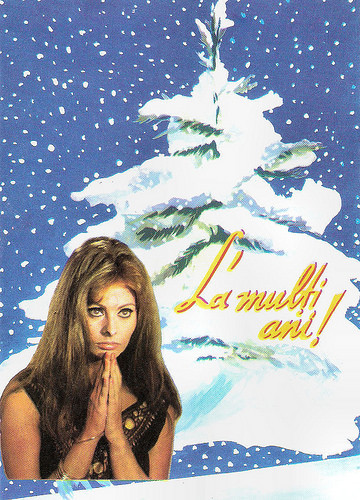
Sophia Loren . Romanian postcard by Casa Filmului Acin.
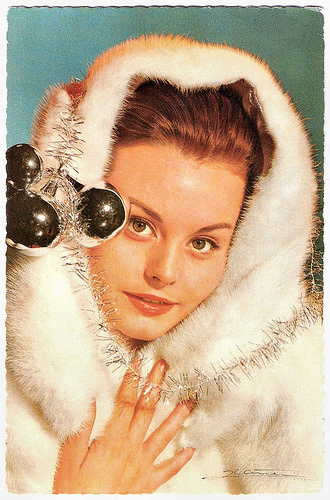
Rocío Dúrcal . Spanish postcard by Ediciones Tarjet-Fher / Ediciones Mandolina, no. 216. Photo: Epoca Films.
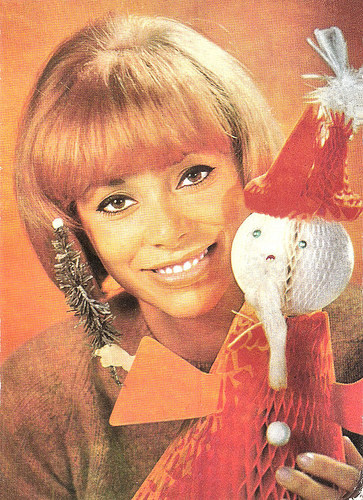
Mireille Darc . Romanian postcard by Casa Filmului Acin, no. 436.
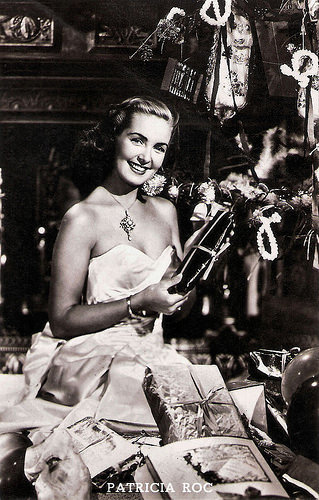
Patricia Roc . Dutch postcard. Photo: British Lion.
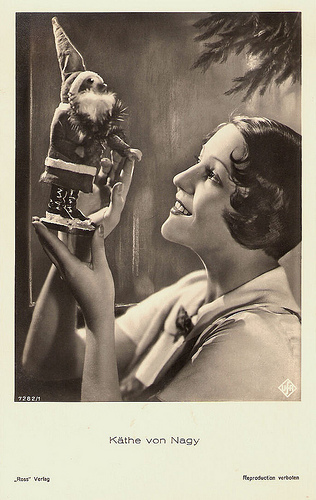
Käthe von Nagy . German postcard by Ross Verlag, no. 7282/1. Photo: Ufa. Released in Italy by Ed. Ballerini & Fratini, Firenze.
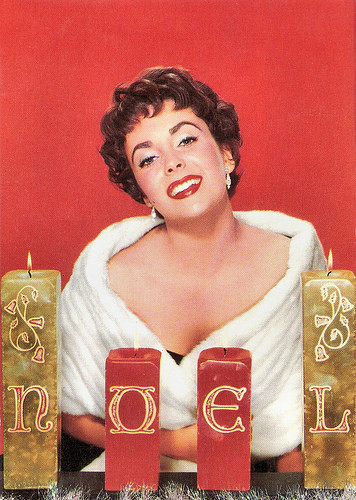
Elizabeth Taylor . French postcard by Editions P.I., Paris, no. 1051. Photo: John Everton / Ufa.
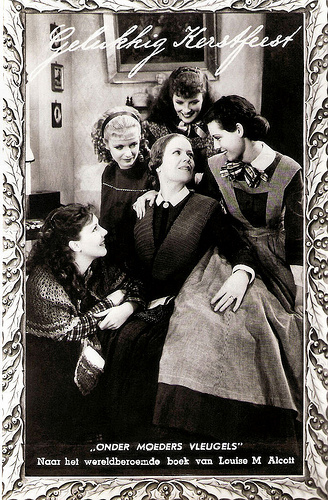
Dutch postcard by the Rialto Theatre, Amsterdam, 1934. Photo: Remaco Radio Picture. Publicity still for Little Women (George Cukor, 1933). In the picture are Katharine Hepburn, Joan Bennett, Frances Dee, Jean Parker and Spring Byington. The Dutch title of the film and the book by Louise M. Alcott is Onder moeders vleugels.
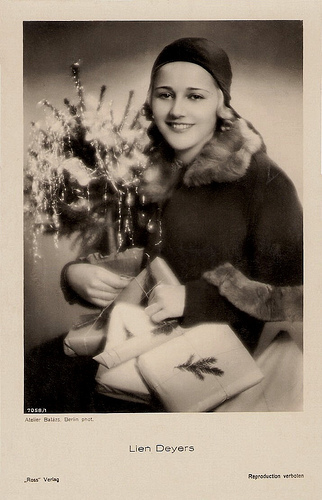
Lien Deyers . German postcard by Ross Verlag, no. 7058/1, 1932-1933. Photo: Atelier Balász, Berlin.
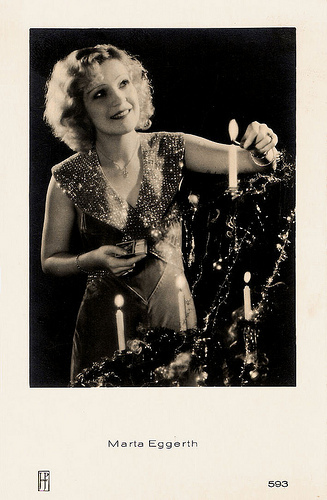
Marta Eggerth . Dutch postcard by JosPe, no. 593.
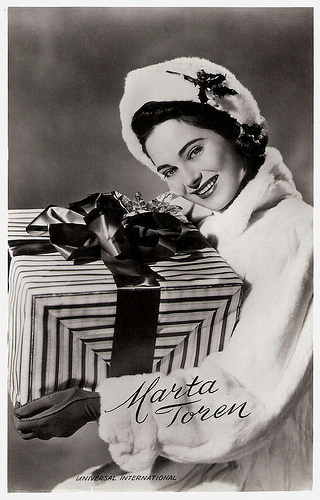
Marta Toren . Dutch postcard, no. 3374. Photo: Universal International / Fotoarchief Film en Toneel.
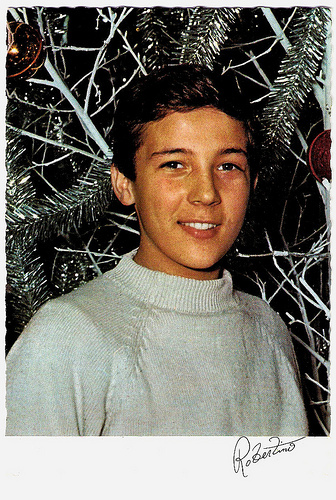
Robertino . French postcard by Editions Publistar, Marseille, no. 811. Photo: President.

Kermit. Dutch postcard by Interstat, Amsterdam. Photo: The Jim Henson Company.
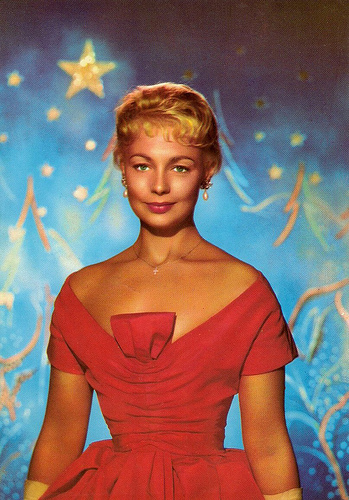
Dany Robin . French postcard by Editions P.I., Paris, no. 1004. Photo: Sam Lévin.
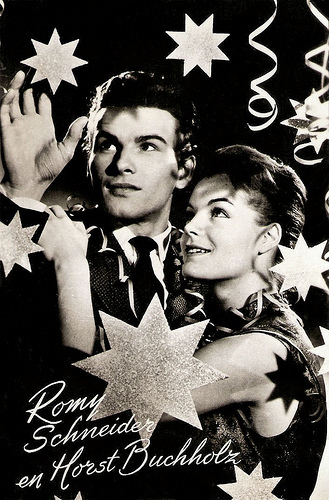
Romy Schneider & Horst Buchholz . Dutch postcard by Uitg. Takken, Utrecht, no. 3572.
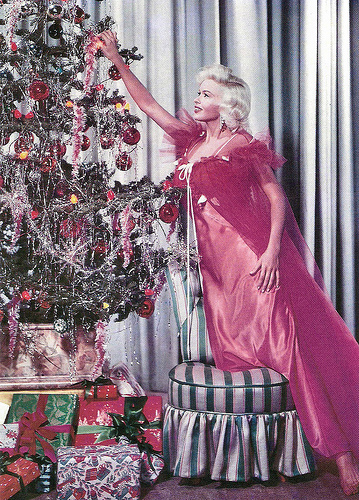
Jayne Mansfield. French postcard by Edition a la carte. Photo: Filmhistorisches Bildarchiv Peter W. Engelmeier.
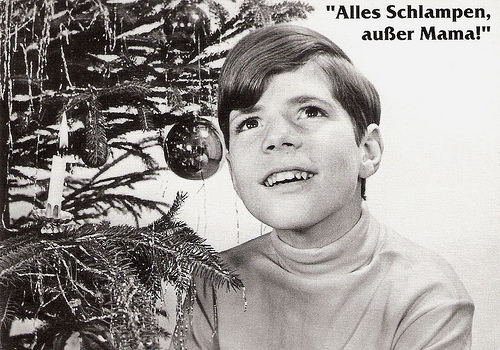
Heintje Simons . German postcard by Modern Times. Photo: Interfoto. Caption: Alles schlampen, ausser mama (All bitches, except mama).
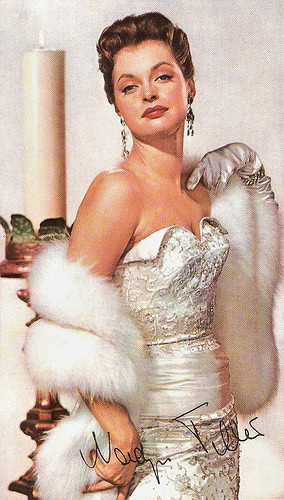
Nadja Tiller . German promotion card for Luxor.

Sophia Loren . Romanian postcard by Casa Filmului Acin.

Rocío Dúrcal . Spanish postcard by Ediciones Tarjet-Fher / Ediciones Mandolina, no. 216. Photo: Epoca Films.

Mireille Darc . Romanian postcard by Casa Filmului Acin, no. 436.

Patricia Roc . Dutch postcard. Photo: British Lion.

Käthe von Nagy . German postcard by Ross Verlag, no. 7282/1. Photo: Ufa. Released in Italy by Ed. Ballerini & Fratini, Firenze.

Elizabeth Taylor . French postcard by Editions P.I., Paris, no. 1051. Photo: John Everton / Ufa.

Dutch postcard by the Rialto Theatre, Amsterdam, 1934. Photo: Remaco Radio Picture. Publicity still for Little Women (George Cukor, 1933). In the picture are Katharine Hepburn, Joan Bennett, Frances Dee, Jean Parker and Spring Byington. The Dutch title of the film and the book by Louise M. Alcott is Onder moeders vleugels.

Lien Deyers . German postcard by Ross Verlag, no. 7058/1, 1932-1933. Photo: Atelier Balász, Berlin.

Marta Eggerth . Dutch postcard by JosPe, no. 593.

Marta Toren . Dutch postcard, no. 3374. Photo: Universal International / Fotoarchief Film en Toneel.

Robertino . French postcard by Editions Publistar, Marseille, no. 811. Photo: President.

Kermit. Dutch postcard by Interstat, Amsterdam. Photo: The Jim Henson Company.

Dany Robin . French postcard by Editions P.I., Paris, no. 1004. Photo: Sam Lévin.

Romy Schneider & Horst Buchholz . Dutch postcard by Uitg. Takken, Utrecht, no. 3572.

Jayne Mansfield. French postcard by Edition a la carte. Photo: Filmhistorisches Bildarchiv Peter W. Engelmeier.

Heintje Simons . German postcard by Modern Times. Photo: Interfoto. Caption: Alles schlampen, ausser mama (All bitches, except mama).

Nadja Tiller . German promotion card for Luxor.
Published on December 24, 2017 22:00
December 23, 2017
Oscar Sabo
Oscar Sabo (1881-1969) was a celebrated Austrian operetta singer and later also a popular film actor.
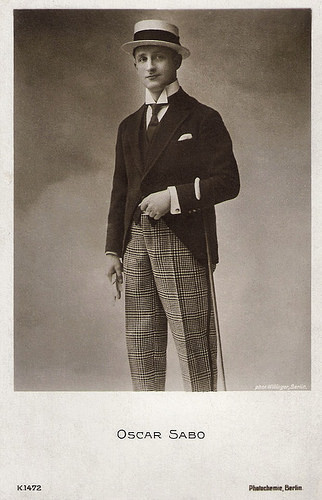
German postcard by Photochemie, no. K. 1472. Photo: Willinger, Berlin.
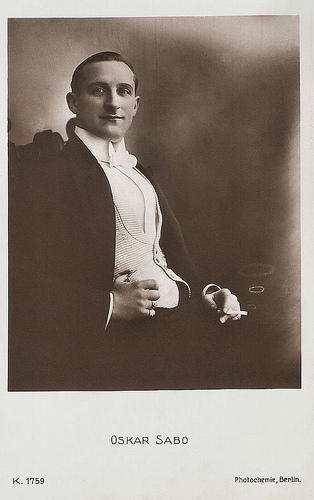
German postcard by Photochemie, no. K. 1759.
Discovered by Max Reinhardt
Oscar or Oskar Sabo was born in 1881 in Vienna, Austria-Hungary.
He was trained at the Stern'schen Konservatorium (now the Julius Stern Institute of the Berlin University of the Arts) in Berlin on the violin. From 1900 onwards, he appeared as an extra in theatre plays.
When Max Reinhardt discovered him, Sabo received an engagement at the Berliner Theater. He was particularly active in farces and operettas, in which he also performed as a singer.
In 1912, he had great successes in two operettas by Walter Kollo, Große Rosinen (Great Raisins) and Filmzauber (Film Magic). Together with Lisa Weise , he was the first interpreter of Kollo’s popular marching song Untern Linden.
Oscar Sabo made his film debut in one of Austria’s first films, the short silent comedy Die böse Schwiegermutter/The Evil Mother-in-law (Anton Kolm, 1910). His first German film was Kehre zurück! Alles vergeben!/Come back! All forgiven! (Max Mack, 1914). He then played the title role in the comedy Der Barbier von Filmersdorf/The Barber of Filmersdorf (Carl Wilhelm, 1915) with Anna Müller-Lincke.
During the silent film era, the film industry only used Sabo incidentally. In 1922, he played a part in the historical film Der falsche Dimitri/The False Dimitri (Hans Steinhoff, 1922), starring Alfred Abel . Set in early seventeenth century Russia it portrays the rise of False Dmitriy I during the Time of Troubles.
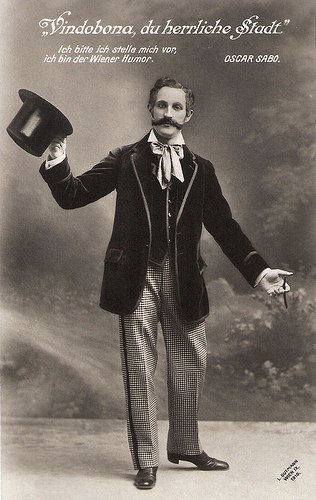
Austrian postcard by Postkartenverlag Brüder Kohn, Wien. Photo: L. Gutmann, Wien, 1910. Caption: "Vindobona, du herrliche Stadt." Ich bitte ich stelle mich vor, ich bin der Wiener Humor. Oscar Sabo.
Much employed as a supporting player
Only when the sound film arrived, the already over fifty-years-old Oscar Sabo suddenly saw himself much employed as a supporting player. He embodied chauffeurs, policemen, drivers, mailmen, and other subordinate figures, whom he usually depicted with humour.
His films include Der kleine Seitensprung/The Little Escapade (Reinhold Schünzel, 1931) with Renate Müller , Der Läufer von Marathon (Ewald André Dupont, 1933) starring Brigitte Helm , G'schichten aus dem Wienerwald/Tales from Vienna Woods (Georg Jacoby, 1934), and Endstation (E.W. Emo, 1935) starring Paul Hörbiger and Hans Moser .
Sabo continued his career undiminished during wartime and entertained audiences with films like Der Gasmann/The Gas Man (Carl Froelich, 1941) with Heinz Rühmann , Reise in die Vergangenheit/Trip to the past (Hans H. Zerlett, 1943), Familie Buchholz/The Buchholz Family (Carl Froelich, 1944) and its direct sequel Neigungsehe/Marriage of Affection (Carl Froelich, 1944), both starring Henny Porten .
After the war, Sabo only appeared rarely in the cinema. His films from this period include Wenn Männer schwindeln/When Men Swindle (Carl Boese, 1950) and Madeleine und der Legionär/ (Wolfgang Staudte, 1958).
His son Oscar Sabo jun. (1922-1978) was also an actor. Oscar Sabo died in 1969 in Berlin. Sabo is buried in the Heerstraße cemetery in the Charlottenburg-Wilmersdorf district, as well as his son.
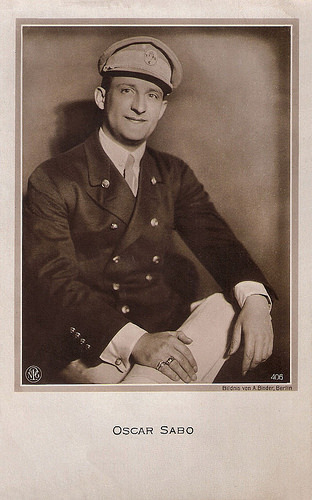
German postcard by NPG, no. 406. Photo: Alex Binder, Berlin.
Sources: Thomas Staedeli (Cyranos), Wikipedia (German and English), and .

German postcard by Photochemie, no. K. 1472. Photo: Willinger, Berlin.

German postcard by Photochemie, no. K. 1759.
Discovered by Max Reinhardt
Oscar or Oskar Sabo was born in 1881 in Vienna, Austria-Hungary.
He was trained at the Stern'schen Konservatorium (now the Julius Stern Institute of the Berlin University of the Arts) in Berlin on the violin. From 1900 onwards, he appeared as an extra in theatre plays.
When Max Reinhardt discovered him, Sabo received an engagement at the Berliner Theater. He was particularly active in farces and operettas, in which he also performed as a singer.
In 1912, he had great successes in two operettas by Walter Kollo, Große Rosinen (Great Raisins) and Filmzauber (Film Magic). Together with Lisa Weise , he was the first interpreter of Kollo’s popular marching song Untern Linden.
Oscar Sabo made his film debut in one of Austria’s first films, the short silent comedy Die böse Schwiegermutter/The Evil Mother-in-law (Anton Kolm, 1910). His first German film was Kehre zurück! Alles vergeben!/Come back! All forgiven! (Max Mack, 1914). He then played the title role in the comedy Der Barbier von Filmersdorf/The Barber of Filmersdorf (Carl Wilhelm, 1915) with Anna Müller-Lincke.
During the silent film era, the film industry only used Sabo incidentally. In 1922, he played a part in the historical film Der falsche Dimitri/The False Dimitri (Hans Steinhoff, 1922), starring Alfred Abel . Set in early seventeenth century Russia it portrays the rise of False Dmitriy I during the Time of Troubles.

Austrian postcard by Postkartenverlag Brüder Kohn, Wien. Photo: L. Gutmann, Wien, 1910. Caption: "Vindobona, du herrliche Stadt." Ich bitte ich stelle mich vor, ich bin der Wiener Humor. Oscar Sabo.
Much employed as a supporting player
Only when the sound film arrived, the already over fifty-years-old Oscar Sabo suddenly saw himself much employed as a supporting player. He embodied chauffeurs, policemen, drivers, mailmen, and other subordinate figures, whom he usually depicted with humour.
His films include Der kleine Seitensprung/The Little Escapade (Reinhold Schünzel, 1931) with Renate Müller , Der Läufer von Marathon (Ewald André Dupont, 1933) starring Brigitte Helm , G'schichten aus dem Wienerwald/Tales from Vienna Woods (Georg Jacoby, 1934), and Endstation (E.W. Emo, 1935) starring Paul Hörbiger and Hans Moser .
Sabo continued his career undiminished during wartime and entertained audiences with films like Der Gasmann/The Gas Man (Carl Froelich, 1941) with Heinz Rühmann , Reise in die Vergangenheit/Trip to the past (Hans H. Zerlett, 1943), Familie Buchholz/The Buchholz Family (Carl Froelich, 1944) and its direct sequel Neigungsehe/Marriage of Affection (Carl Froelich, 1944), both starring Henny Porten .
After the war, Sabo only appeared rarely in the cinema. His films from this period include Wenn Männer schwindeln/When Men Swindle (Carl Boese, 1950) and Madeleine und der Legionär/ (Wolfgang Staudte, 1958).
His son Oscar Sabo jun. (1922-1978) was also an actor. Oscar Sabo died in 1969 in Berlin. Sabo is buried in the Heerstraße cemetery in the Charlottenburg-Wilmersdorf district, as well as his son.

German postcard by NPG, no. 406. Photo: Alex Binder, Berlin.
Sources: Thomas Staedeli (Cyranos), Wikipedia (German and English), and .
Published on December 23, 2017 22:00
December 22, 2017
Doris Kirchner
Austrian stage, film and television actress Doris Kirchner (1930) was a popular comedienne of the German cinema of the 1950s. She both appeared in leading and supporting roles.
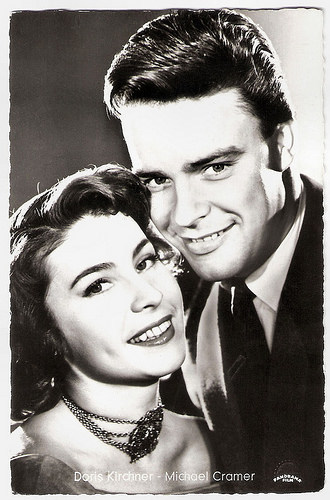
West-German postcard by Kolibri-Verlag, no. 1957. Photo: Panorama / Wolf. Publicity still for Der Jäger von Roteck/The Huntsman of Roteck (Hermann Kugelstadt, 1956) with Michael Cramer .
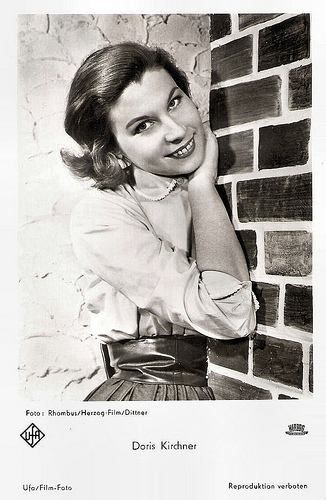
West-German postcard by Ufa, Berlin-Tempelhof, no. FK 3715. Photo: Rhombus / Herzog-Film / Dittner. Publicity still for Das Glück liegt auf der Strasse/Happiness is on the street (Franz Antel, 1957).
Cross-dressing comedy
Doris Kirchner was born in 1930 in Graz, Austria.
At the end of the 1940s, she attended the Max Reinhardt Schule in Wien (Vienna). Later she performed at the renowned Burgtheater in Vienna.
In 1949 she made her film debut in the Austrian Heimatfilm Das Siegel Gottes/The Seal of the Lord (Alfred Stöger, 1949). It was one of the first films in the postwar era to use the seal of confession as a substantive issue.
During the 1950s she appeared in such films as comedy Seitensprünge im Schnee/Escapades in the Snow (Siegfried Breuer, 1950) with Heinz Engelmann, Abenteuer im Schloss/Adventures in the Castle (Rudolf Steinboeck, 1952) and Wo die Lerche singt/Where the Lark Sings (Hans Wolff, 1956) with Renate Holm, based on the operetta by the Hungarian composer Franz Lehár.
She also played supporting parts in such films as the cross-dressing comedy Fanfaren der Ehe/Fanfare of Marriage (Hans Grimm, 1953) starring Dieter Borsche and Georg Thomalla , and Ich und Du/I and You (Alfred Weidenmann, 1953) starring Hardy Krüger and Liselotte Pulver .
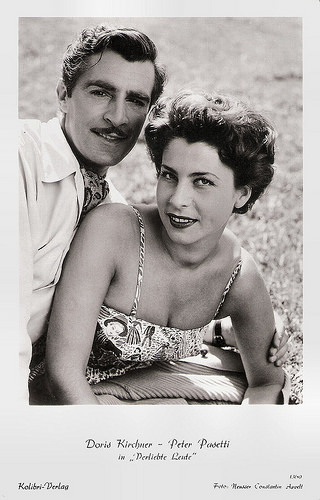
West-German postcard by Kolibri-Verlag, no. 1369. Photo: Neusser / Constantin / Appelt. Publicity still for Verliebte Leute/Loving Couples (Franz Antel, 1954) with Peter Pasetti .
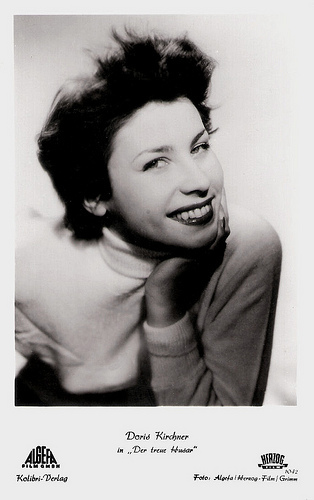
German postcard by Kolibri-Verlag, no. 1042. Photo: Algefa / Herzog-Film / Grimm. Publicity still for Der treue Husar/The Faithfull Hussar (Rudolf Schündler, 1954).
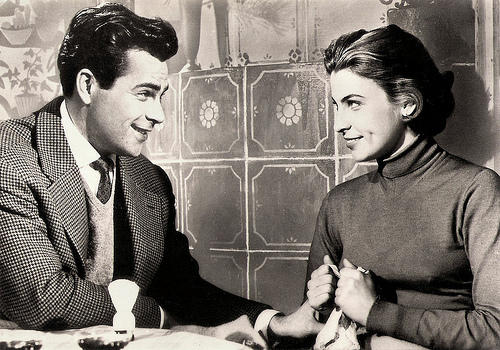
East-German postcard by VEB Progress Film-Vertrieb, Berlin, no. 1500, 1961. Photo: publicity still for Lügen haben hübsche Beine/Lies have pretty legs (Erik Ode, 1956) with Adrian Hoven .
The Creepiest, Crawliest and Deadliest Film Ever Produced!
Doris Kirchner was married to the directors Helmuth Ashley and Franz Josef Gottlieb. With her second husband, she made several light entertainment films during the 1960s and 1970s.
Their first film together was the German-Spanish crime film Das Geheimnis der schwarzen Witwe/The Secret of the Black Widow (Franz Josef Gottlieb, 1963) starring O. W. Fischer and Klaus Kinski . It was based on one of the crime novels by Louis Weinert-Wilton.
After the success of their Edgar Wallace series, Constantin film tried to copy this success with a series of four Louis Weinert-Wilton adaptations. Although the film was advertised as 'The Creepiest, Crawliest and Deadliest Film Ever Produced!'most critics found the film quite dull.
Gottlieb and Kirchner followed this with the saccharine musical comedy Wenn du bei mir bist/When You're With Me (Franz Josef Gottlieb, 1970) starring Roy Black and Lex Barker. Filming took place in international settings including several airports. Location filming was done in Germany as well as Bangkok and Colombo.
Kirchner also appeared in three farces with Rudi Carrell, Wenn die tollen Tanten kommen/When the Mad Aunts Arrive (Franz Josef Gottlieb, 1970) also with Ilja Richter and Schlager singer Chris Roberts, Tante Trude aus Buxtehude/Aunt Trude from Buxtehude (Franz Josef Gottlieb, 1971), and Rudi, benimm dich!/Rudi, Behave! (Franz Josef Gottlieb, 1971).
These Rudi Carrell comedies were among the several German films in the wake of Some Like it Hot (Billy Wilder, 1959) that used cross-dressing as a comic theme and were inspired by the cross-dressing plot of Charley's Aunt. In turn, Some Like it Hot was again based on the German comedy Fanfaren der Liebe/Fanfares of Love (Kurt Hoffmann, 1951). While Kirchner had 20 years earlier appeared in the sequel of this film, Fanfaren der Ehe/Fanfare of Marriage (Hans Grimm, 1953).
In 1988, Doris Kirchner became the manager of Schauspielschule Bühnenstudio Hamburg. Her last screen role was in the TV series Wolken über Kaprun/Clouds over Kaprun (Franz Josef Gottlieb, 1993).
At the age of 73, Doris Kirchner suffered a stroke that caused dementia. Today she lives in an old people's home near Hamburg. In 2011, film makers Kirsten Poggendorff and Michael Wolfram made a film about her there, Müllerstochter, Königin ... - Porträt der Schauspielerin Doris Kirchner/Miller's daughter, Queen ... - Portrait of the actress Doris Kirchner (2011).
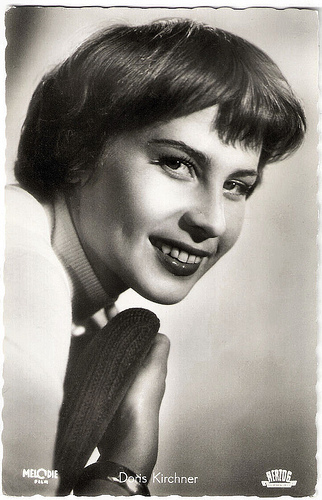
German postcard by Kolibri-Verlag, Minden-Westf. Photo: Melodie / Sandrew / Herzog-Film / A. Grimm. Publicity still for Sommarflickan/Swedish Girl (Håkan Bergström, Thomas Engel, 1955).
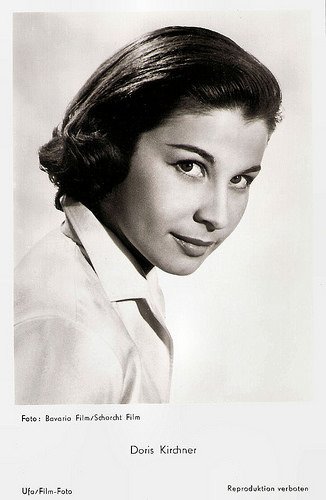
West-German postcard by Ufa, Berlin-Tempelhof, no. FK 3687. Photo: Bavaria Film / Schorcht Film. Publicity still for Vater, unser bestes Stück/Father, our best piece (Günther Lüders, 1957).
Sources: Christina Bylow (Berliner Zeitung - German), Wikipedia and .

West-German postcard by Kolibri-Verlag, no. 1957. Photo: Panorama / Wolf. Publicity still for Der Jäger von Roteck/The Huntsman of Roteck (Hermann Kugelstadt, 1956) with Michael Cramer .

West-German postcard by Ufa, Berlin-Tempelhof, no. FK 3715. Photo: Rhombus / Herzog-Film / Dittner. Publicity still for Das Glück liegt auf der Strasse/Happiness is on the street (Franz Antel, 1957).
Cross-dressing comedy
Doris Kirchner was born in 1930 in Graz, Austria.
At the end of the 1940s, she attended the Max Reinhardt Schule in Wien (Vienna). Later she performed at the renowned Burgtheater in Vienna.
In 1949 she made her film debut in the Austrian Heimatfilm Das Siegel Gottes/The Seal of the Lord (Alfred Stöger, 1949). It was one of the first films in the postwar era to use the seal of confession as a substantive issue.
During the 1950s she appeared in such films as comedy Seitensprünge im Schnee/Escapades in the Snow (Siegfried Breuer, 1950) with Heinz Engelmann, Abenteuer im Schloss/Adventures in the Castle (Rudolf Steinboeck, 1952) and Wo die Lerche singt/Where the Lark Sings (Hans Wolff, 1956) with Renate Holm, based on the operetta by the Hungarian composer Franz Lehár.
She also played supporting parts in such films as the cross-dressing comedy Fanfaren der Ehe/Fanfare of Marriage (Hans Grimm, 1953) starring Dieter Borsche and Georg Thomalla , and Ich und Du/I and You (Alfred Weidenmann, 1953) starring Hardy Krüger and Liselotte Pulver .

West-German postcard by Kolibri-Verlag, no. 1369. Photo: Neusser / Constantin / Appelt. Publicity still for Verliebte Leute/Loving Couples (Franz Antel, 1954) with Peter Pasetti .

German postcard by Kolibri-Verlag, no. 1042. Photo: Algefa / Herzog-Film / Grimm. Publicity still for Der treue Husar/The Faithfull Hussar (Rudolf Schündler, 1954).

East-German postcard by VEB Progress Film-Vertrieb, Berlin, no. 1500, 1961. Photo: publicity still for Lügen haben hübsche Beine/Lies have pretty legs (Erik Ode, 1956) with Adrian Hoven .
The Creepiest, Crawliest and Deadliest Film Ever Produced!
Doris Kirchner was married to the directors Helmuth Ashley and Franz Josef Gottlieb. With her second husband, she made several light entertainment films during the 1960s and 1970s.
Their first film together was the German-Spanish crime film Das Geheimnis der schwarzen Witwe/The Secret of the Black Widow (Franz Josef Gottlieb, 1963) starring O. W. Fischer and Klaus Kinski . It was based on one of the crime novels by Louis Weinert-Wilton.
After the success of their Edgar Wallace series, Constantin film tried to copy this success with a series of four Louis Weinert-Wilton adaptations. Although the film was advertised as 'The Creepiest, Crawliest and Deadliest Film Ever Produced!'most critics found the film quite dull.
Gottlieb and Kirchner followed this with the saccharine musical comedy Wenn du bei mir bist/When You're With Me (Franz Josef Gottlieb, 1970) starring Roy Black and Lex Barker. Filming took place in international settings including several airports. Location filming was done in Germany as well as Bangkok and Colombo.
Kirchner also appeared in three farces with Rudi Carrell, Wenn die tollen Tanten kommen/When the Mad Aunts Arrive (Franz Josef Gottlieb, 1970) also with Ilja Richter and Schlager singer Chris Roberts, Tante Trude aus Buxtehude/Aunt Trude from Buxtehude (Franz Josef Gottlieb, 1971), and Rudi, benimm dich!/Rudi, Behave! (Franz Josef Gottlieb, 1971).
These Rudi Carrell comedies were among the several German films in the wake of Some Like it Hot (Billy Wilder, 1959) that used cross-dressing as a comic theme and were inspired by the cross-dressing plot of Charley's Aunt. In turn, Some Like it Hot was again based on the German comedy Fanfaren der Liebe/Fanfares of Love (Kurt Hoffmann, 1951). While Kirchner had 20 years earlier appeared in the sequel of this film, Fanfaren der Ehe/Fanfare of Marriage (Hans Grimm, 1953).
In 1988, Doris Kirchner became the manager of Schauspielschule Bühnenstudio Hamburg. Her last screen role was in the TV series Wolken über Kaprun/Clouds over Kaprun (Franz Josef Gottlieb, 1993).
At the age of 73, Doris Kirchner suffered a stroke that caused dementia. Today she lives in an old people's home near Hamburg. In 2011, film makers Kirsten Poggendorff and Michael Wolfram made a film about her there, Müllerstochter, Königin ... - Porträt der Schauspielerin Doris Kirchner/Miller's daughter, Queen ... - Portrait of the actress Doris Kirchner (2011).

German postcard by Kolibri-Verlag, Minden-Westf. Photo: Melodie / Sandrew / Herzog-Film / A. Grimm. Publicity still for Sommarflickan/Swedish Girl (Håkan Bergström, Thomas Engel, 1955).

West-German postcard by Ufa, Berlin-Tempelhof, no. FK 3687. Photo: Bavaria Film / Schorcht Film. Publicity still for Vater, unser bestes Stück/Father, our best piece (Günther Lüders, 1957).
Sources: Christina Bylow (Berliner Zeitung - German), Wikipedia and .
Published on December 22, 2017 22:00
December 21, 2017
Valentine's Postcards
Valentine’s Co. (1825-1963) was one of the largest postcard publishers in the early 1900s. It's thought that more than a million photographs were taken for the company.
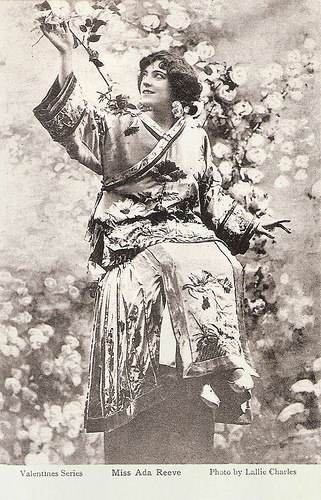
Ada Reeve . British postcard in the Valentine Series. Photo: Lallie Charles (née Charlotte Elizabeth Martin). Possibly this was a publicity still for the stage musical San Toy. Reeve joined the cast of this hit musical in 1901, playing Dudley and later taking over the title role from Marie Tempest.
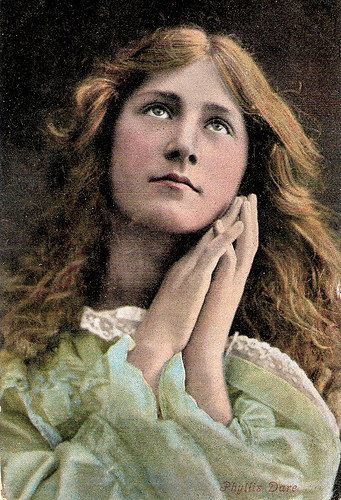
Phyllis Dare . British postcard in the Valentine's Series. Photo: Foulsham & Banfield.
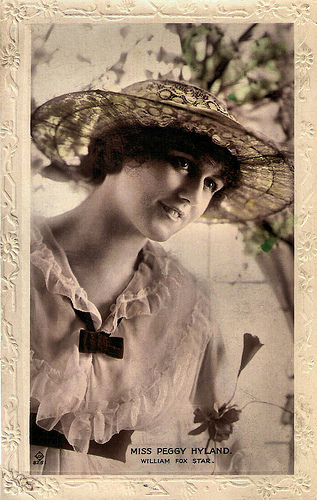
Peggy Hyland . British postcard in Valentine's Real Photograph series, no. 8251. Photo: William Fox.
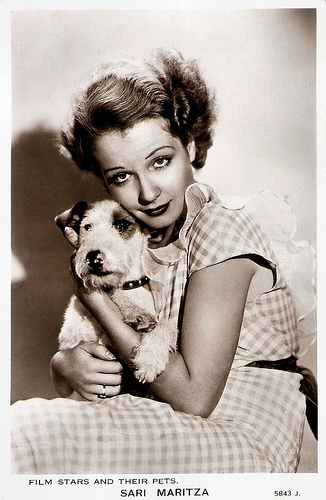
Sari Maritza. British postcard by Valentine's in the Film Stars and Their Pets series, no. 5843 J. Photo: Paramount Pictures.

Heather Angel . British postcard by Valentine's Postcards in the Film Stars and Their Pets series, no. 5843 L.
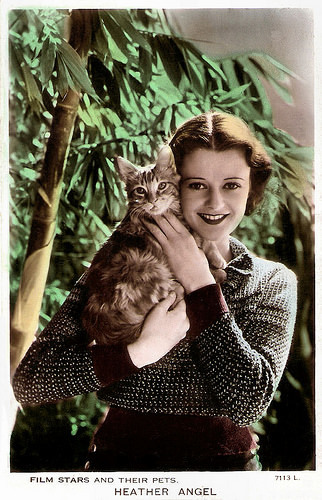
Heather Angel . British postcard by Valentine's Postcards in the Film Stars and Their Pets series, no. 7113 L, ca. 1934.
Film Stars and Their Pets
The Valentine Company, a lithographic printing firm, was founded in 1825 in Dundee, Scotland by engraver John Valentine. His son James became a partner five years later. James was an early pioneer of photography and by the 1860s his work was being reproduced by the Valentine Company as prints and stereo-views.
After James’ death in 1879 his two sons, George Dobson and William Dobson took over the Company, but in 1884 George moved to New Zealand where he became a landscape photographer. In 1880 Valentine began producing Christmas cards and by 1896 they began printing postcards.
Up until 1882 they had only published views of Scotland, but they began expanding into other tourist markets especially after their postcard business took off. Other offices opened in Jamaica, Medeira, Norway, Tangier, Canada, and New York. They produced a great range of postcards that were mostly printed in Scotland in tinted halftone lithography or issued as real photo cards.
From 1900, an increasing number of images were bought in from local and national photographers and agencies including George Washington Wilson, Donald George of Gwynedd, society photographers such as Karsh of Ottawa, Dorothy Wilding and Baron who sold publishing rights to Valentines.
Valentine's created several film star postcard series, including the Film Stars and Their Pets series and the Famous Film Stars series. Among Valentine's noted series are also Disney and Bonzo. In addition they produced a vast array of other products that held photographic images. All interests outside of Great Britain were sold in 1923.
By 1929 they had given up their photo portraiture work to concentrate solely on postcard production. But they did not anticipate the public’s growing demand for color cards and by the 1950s their business was suffering. In return they put most of their efforts into greeting cards. They were purchased by John Waddington & Co. in 1963, which passed on to Hallmark Cards in 1980. Dundee operations closed in 1994.
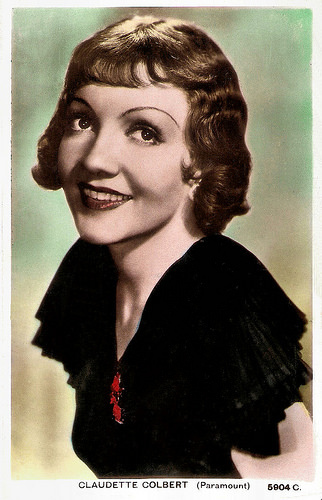
Claudette Colbert. British postcard by Valentine's, no. 5904 C. Photo: Paramount.
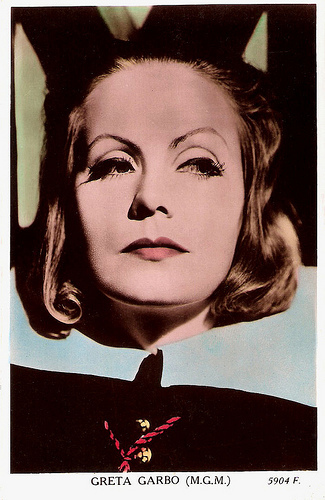
Greta Garbo . British postcard by Valentine's Postcard in the Real Photograph series, no. 5904 F. Photo: MGM. Publicity still for Queen Christina (1933).

Douglas Fairbanks Jr. British postcard by Valentine's, no. 5904 N. Photo: London Films. Publicity still for The Rise of Catherine the Great (Paul Czinner, 1934).

Gracie Fields . British postcard by Valentine's Postcard, no. 7121.
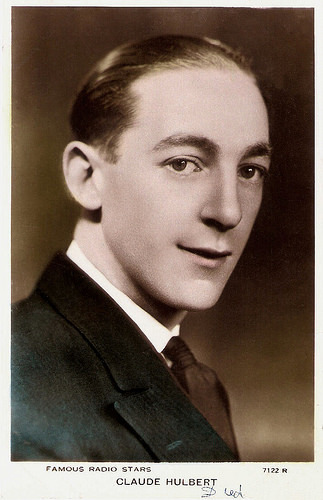
Claude Hulbert . British postcard by Valentine's in the Famous Radio Stars series, no. 7122 M.
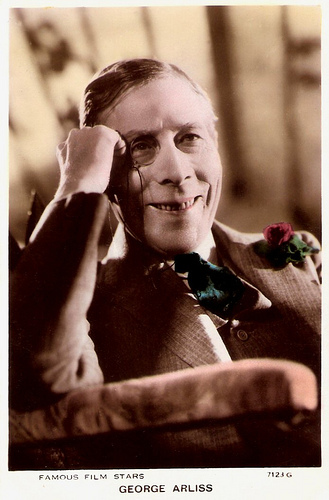
George Arliss . British postcard by Valentine's in the Famous Film Stars series, no. 7123G.
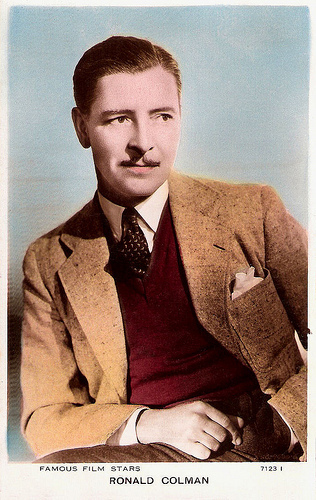
Ronald Colman . British postcard by Valentine's in the Famous Film Stars Series, no. 7123 I.
Sources: About Postcards, Metro Postcard Com, Collections, Archives hub and Ross Postcards.
It is Postcard Friendship Friday, hosted by Beth at the The Best Hearts are Crunchy. You can visit her by clicking on the button below.


Ada Reeve . British postcard in the Valentine Series. Photo: Lallie Charles (née Charlotte Elizabeth Martin). Possibly this was a publicity still for the stage musical San Toy. Reeve joined the cast of this hit musical in 1901, playing Dudley and later taking over the title role from Marie Tempest.

Phyllis Dare . British postcard in the Valentine's Series. Photo: Foulsham & Banfield.

Peggy Hyland . British postcard in Valentine's Real Photograph series, no. 8251. Photo: William Fox.

Sari Maritza. British postcard by Valentine's in the Film Stars and Their Pets series, no. 5843 J. Photo: Paramount Pictures.

Heather Angel . British postcard by Valentine's Postcards in the Film Stars and Their Pets series, no. 5843 L.

Heather Angel . British postcard by Valentine's Postcards in the Film Stars and Their Pets series, no. 7113 L, ca. 1934.
Film Stars and Their Pets
The Valentine Company, a lithographic printing firm, was founded in 1825 in Dundee, Scotland by engraver John Valentine. His son James became a partner five years later. James was an early pioneer of photography and by the 1860s his work was being reproduced by the Valentine Company as prints and stereo-views.
After James’ death in 1879 his two sons, George Dobson and William Dobson took over the Company, but in 1884 George moved to New Zealand where he became a landscape photographer. In 1880 Valentine began producing Christmas cards and by 1896 they began printing postcards.
Up until 1882 they had only published views of Scotland, but they began expanding into other tourist markets especially after their postcard business took off. Other offices opened in Jamaica, Medeira, Norway, Tangier, Canada, and New York. They produced a great range of postcards that were mostly printed in Scotland in tinted halftone lithography or issued as real photo cards.
From 1900, an increasing number of images were bought in from local and national photographers and agencies including George Washington Wilson, Donald George of Gwynedd, society photographers such as Karsh of Ottawa, Dorothy Wilding and Baron who sold publishing rights to Valentines.
Valentine's created several film star postcard series, including the Film Stars and Their Pets series and the Famous Film Stars series. Among Valentine's noted series are also Disney and Bonzo. In addition they produced a vast array of other products that held photographic images. All interests outside of Great Britain were sold in 1923.
By 1929 they had given up their photo portraiture work to concentrate solely on postcard production. But they did not anticipate the public’s growing demand for color cards and by the 1950s their business was suffering. In return they put most of their efforts into greeting cards. They were purchased by John Waddington & Co. in 1963, which passed on to Hallmark Cards in 1980. Dundee operations closed in 1994.

Claudette Colbert. British postcard by Valentine's, no. 5904 C. Photo: Paramount.

Greta Garbo . British postcard by Valentine's Postcard in the Real Photograph series, no. 5904 F. Photo: MGM. Publicity still for Queen Christina (1933).

Douglas Fairbanks Jr. British postcard by Valentine's, no. 5904 N. Photo: London Films. Publicity still for The Rise of Catherine the Great (Paul Czinner, 1934).

Gracie Fields . British postcard by Valentine's Postcard, no. 7121.

Claude Hulbert . British postcard by Valentine's in the Famous Radio Stars series, no. 7122 M.

George Arliss . British postcard by Valentine's in the Famous Film Stars series, no. 7123G.

Ronald Colman . British postcard by Valentine's in the Famous Film Stars Series, no. 7123 I.
Sources: About Postcards, Metro Postcard Com, Collections, Archives hub and Ross Postcards.
It is Postcard Friendship Friday, hosted by Beth at the The Best Hearts are Crunchy. You can visit her by clicking on the button below.

Published on December 21, 2017 22:00
Paul van Yperen's Blog
- Paul van Yperen's profile
- 13 followers
Paul van Yperen isn't a Goodreads Author
(yet),
but they
do have a blog,
so here are some recent posts imported from
their feed.



